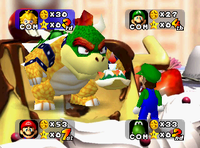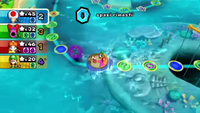Mario Party (series): Difference between revisions
PanchamBro (talk | contribs) (Undo revision 1616916 by LumaMaster (talk) Stop Speculating.) |
(→Playable characters: Since the table and order of the list are based on character rosters (or certain modes or unlocks), Pauline is basically listed first in the roster. Otherwise Red Toad to Yellow Toad are listed under Diddy because they are not in the official character roster.) |
||
| (779 intermediate revisions by more than 100 users not shown) | |||
| Line 1: | Line 1: | ||
{{italic title | {{italic title}} | ||
{{series | {{FA}} | ||
{{series infobox | |||
|image=[[File: | |image=[[File:Mario_Party_2021_Logo_.png|250px]]<br>The current logo, formatted like the [[:File:Mario_Party_Superstars_logo.png|logo from ''Mario Party Superstars'']] | ||
|first=''[[Mario Party]]'' ([[1998]]) | |first=''[[Mario Party]]'' ([[List of games by date#1998|1998]]) | ||
|latest=''[[Mario Party | |latest=''[[Super Mario Party Jamboree]]'' ([[List of games by date#2024|2024]]) | ||
|number= | |number=26 (13 main, 6 handheld, 7 arcade) | ||
| | |franchise=''[[Super Mario (franchise)|Super Mario]]'' | ||
}} | }} | ||
The '' | {{quote|{{wp|Olympic Games|The Olympics}}, {{wp|Jeopardy!|Final Jeopardy!}}, {{wp|monster truck}} extravaganzas... They're all mere child's play compared to the biggest showcase of brains, talent, and stamina of our time: ''Mario Party''!|''[[Nintendo Power]]'' Issue #117, February 1999}} | ||
The '''''Mario Party''''' series is a series of {{wp|party game}}s featuring the characters of the [[Super Mario (franchise)|''Super Mario'' franchise]], in which four human- or computer-controlled characters compete in a board game interspersed with {{wp|minigame}}s. The series is known for its party game elements, including the often unpredictable multiplayer modes that allow play with up to four (and, in one case, eight) human players. The series was created under [[Nintendo]]'s supervision by [[Hudson Soft]] and [[CAProduction]], and was inaugurated on the [[Nintendo 64]], where its first game launched in Japan on December 18, 1998, and in the West in early 1999. | |||
[[ | Hudson developed all main installments until several of its key designers and most of its staff left the company. After eight entries on home consoles and two on handhelds, the ex-Hudson staffers then joined [[Nintendo Cube|Nd Cube]], where they developed ''{{wp|Wii Party}}'',<ref>Ashcraft, Brian (August 25, 2010). "[http://kotaku.com/5621293/what-wii-party-and-mario-party-have-in-common What ''Wii Party'' and ''Mario Party'' Have in Common]". ''Kotaku''. August 26, 2010.</ref> then restarted production of the ''Mario Party'' series, with the new development studio's first installment, ''[[Mario Party 9]]'', releasing on the [[Wii]] in 2012. | ||
The ''Mario Party'' series | The ''Mario Party'' series currently holds the record for the longest-running minigame series in video game history.<ref>''Guinness World Records 2011: Gamer's Edition''. Guinness World Records Ltd. 2010. Pg. 86. ISBN 978-1-4053-6546-8.</ref> According to Nintendo's official reports, by December 2014, the various games in the series had sold a cumulative total of 39.6 million copies worldwide.<ref>[https://www.nintendo.co.uk/News/2015/February/Bring-along-your-amiibo-as-your-party-plus-one-from-20th-March-in-Mario-Party-10-960841.html "Bring along your amiibo as your party plus: one from March 20th in ''Mario Party 10'']. Nintendo of Europe. February 19, 2015.</ref> The series has sold a total of 75.84 million copies.<ref> | ||
''Mario Party'' to ''Mario Party: Island Tour'': 39.6 million<br> | |||
''Mario Party 10'': 2.26 million<br> | |||
''Mario Party: Star Rush'' and ''Mario Party: The Top 100'': 427,566 (Japan)<br> | |||
''Super Mario Party'': 20.66 million<br> | |||
''Mario Party Superstars'': 12.89 million<br> | |||
</ref> | |||
==Gameplay== | |||
[[File:MP10 Car Group Art.png|thumb|Mario, Luigi, Princess Peach, and Yoshi are the only four characters to be playable in every installment of the ''Mario Party'' series, excluding the card game ''[[Mario Party-e]]''. If ''Mario Party-e'' is counted, only Mario and Yoshi have this trait.]] | |||
The ''Mario Party'' series takes the form of a traditional board game that players can play by directing characters on various themed game [[board (Mario Party series)|board]]s. Playable character rosters generally consist of major ''Super Mario'' characters, including the main protagonist, [[Mario]]; his brother, [[Luigi]]; his love interest, [[Princess Peach]]; his sidekick [[Yoshi]]; his antagonists and rivals [[Wario]], [[Donkey Kong]], [[Waluigi]], and [[Boo]]; and his friends [[Toad]], [[Princess Daisy]], [[Toadette]], [[Birdo]], and [[Rosalina]], among others. Each game features its own variations on the cast and storyline, with [[Bowser]], the archnemesis of Mario and most of his friends, serving as the main antagonist in most ''Mario Party'' titles. There are several modes available for play in each game, each of which provides its own rules and challenges. | |||
== | ===Party Mode=== | ||
[[File:MP3 Spiny Desert Screenshot.png|thumb|left|Board gameplay from ''[[Mario Party 3]]'']] | |||
Every game in the "main" branch of the ''Mario Party'' series has a standard "Party Mode" in which up to four players play through a board, trying to collect as many [[Star (Mario Party series)|Star]]s as possible. In every turn, each player rolls (hits) a [[Dice Block]] and moves ahead the number of [[Space (Mario Party series)|space]]s shown (ranging from 1 to 10) to make progress on the board, which usually has branching paths. There are many different types of spaces players can land on, each producing a different effect. On most boards, players earn Stars by reaching a [[Star Space]] in a random location on the board and purchasing the Star for the specific number of [[coin]]s stated (usually 20). Every time the Star is purchased, the Star Space moves to one of several predetermined alternate locations, almost always occupying a [[Blue Space]]. In early games, players could also pay a visit to or use items with Boo and have him steal coins or Stars from their opponents for 5 or 50 coins, respectively. In addition to buying the Stars, coins are also necessary to purchase power-up items and to determine the game winner in the event of a tie. Players gain coins by landing on Blue Spaces or performing well in the [[minigame]] played at the end of each turn, and they lose them by landing on [[Red Space]]s or by losing certain minigames. | |||
At the end of each round of play (i.e., after each of the four players has taken their turn), a random minigame commences. The minigames are generally short (about a minute in length) and fairly simple. In most situations, winners of a minigame receive 10 coins for their victory; sometimes, losers have to pay winners a sum of coins. Each ''Mario Party'' game features any number of minigames (ranging from 50 to 90), divided into several different categories. 4-Player minigames include cooperative games, in which all four players collectively win or lose; competitive free-for-alls, in which players must compete against each other in order to win a limited number of coins; and non-competitive free-for-alls, in which players accrue coins independently of one another and one player's loss is not automatically another's gain. Other minigame categories include 2-vs.-2 games, which place players on teams so that they have to cooperate with others to win (though they still compete against each other in the main game); 1-vs.-3 games, where a lone player is placed against a team of three, and either the team or the lone player must survive for a certain amount of time while the opposition tries to take them out; and single-player games, which occur when a player lands on a special space and give them the opportunity to earn or lose coins depending on their performance. Playing in these minigame categories often depends on the color of the space players have landed on. For example, if two players land on a Blue Space and two players land on a Red Space, a 2-vs.-2 minigame is initiated. If a player lands on a green space, the game randomly decides whether the character color is blue or red. | |||
Three new types of minigames were introduced in ''[[Mario Party 2]]''. Battle minigames are like the 4-Player minigames, but instead of winners earning 10 coins each, each player contributes a randomly selected number of coins. The winner of the minigame receives approximately 70% of the pot, the second-place finisher receives the other 30%, and a random player occasionally gets coins left over from rounding. Item minigames allow a single player to take a chance to collect an item, which can be used to further their board strategy. Duel minigames pit two players against each other, with the player that initiates the duel wagering coins or even a Star against their opponent; the winner receives all coins or Stars wagered. Starting with ''[[Mario Party 7]]'', the player no longer chooses the wager in a duel. Rather, the duel takes place, and the prize to the winner, if any, is randomly determined. | |||
[[File:MP1 Bowser Cake.png|thumb|[[Luigi]] encountering [[Bowser]] in ''[[Mario Party]]'']] | |||
Bowser has taken on varied roles in the gameplay of the ''Mario Party'' series. In almost all entries, he can be summoned via a [[Bowser Space|special space of his own]], where he tries to steal from the player. Starting in ''[[Mario Party 4]]'', he hosts his own minigames, where in addition to rewarding the winning player, he tries to burn the losing players with his fire breath, forcing them to give up coins, items, or even Stars. Bowser's minigames originally appeared only in multiplayer format, but starting in ''Mario Party 7'', single-player games of that category began to be featured. His son, [[Bowser Jr.]], got his own minigames starting in ''[[Mario Party 9]]'', where he challenges two players to compete in a minigame with him. If Bowser Jr. is successfully defeated, the players each receive five [[Mini Star]]s; if not, then he takes five from each player. In ''[[Mario Party 10]]'', Bowser became a playable character in a mode all his own, where he, controlled by a fifth player, would challenge the other four players as they progressed through the game by trying to catch them and take away their hit points. | |||
At the end of the game, [[Bonus Star]]s are given to the players. In the first six games, there are three Bonus Stars given out. The Coin Star award is given to the player who collected the most coins overall during the game, the Minigame Star award is awarded to the player who collected the most coins in minigames, and the Happening Star award is given to the player who landed on the most [[Event Space]]s. In ''Mario Party 7'', ''[[Mario Party 8]]'', and ''[[Mario Party DS]]'', the roster of potential Bonus Stars was expanded to six; still, only three would be chosen, and it was random as to which ones got picked. It is common for more than one character to be awarded the same Bonus Star; this happens if there is a tie for the category in question. The player with the most Stars after the bonus awarding has concluded is declared the winner. In the event of a tie, the player with the most coins wins, and if two or more players have the same number of both Stars and coins, a Dice Block is rolled to determine the winner. | |||
[[File:MP9 Prerelease Blooper Beach.png|thumb|left|Players in the ''Mario Party 9'' format of board gameplay]] | |||
Starting in ''Mario Party 9'', the format of the series was overhauled. Instead of trying to collect coins to buy Stars, players receive Mini Stars if they pass by them. While doing that, players must also try to avoid [[Mini Ztar]]s, which deduct their current number of Mini Stars. Furthermore, ''Mario Party 9'' and ''Mario Party 10'' had all four players moving around together in one vehicle, instead of each player having to wait their turn in a single spot on the board. The number of potential Bonus Stars was reduced to five, and in ''Mario Party 10'', the number of Stars that would be chosen was also reduced to two. At the end of each stage, the number of Mini Stars the player collects is converted into [[Mario Party Point|Party Points]], which can be used to buy new stages, difficulties, and bonus content. | |||
Most of the handheld installments in the ''Mario Party'' series feature drastically different rules than their console counterparts, with the exception of ''Mario Party DS''. ''[[Mario Party Advance]]'' is a more single-player oriented game in which players go through [[Shroom City (Mario Party Advance)|Shroom City]] and solve various quests with characters, each having their own story arc. ''[[Mario Party: Island Tour]]'' has characters racing their opponents to the finish line with each board having unique rules and requirements, and ''[[Mario Party: Star Rush]]'' has characters exploring a nonlinear, grid-based layout while playing as a generic Toad, collecting characters of the ''Super Mario'' franchise as they appear on the board and defeating bosses in their special minigames. ''[[Mario Party: The Top 100]]'' focuses entirely on minigames, where the board gameplay is secondary, vice versa to other ''Mario Party'' games' focuses on board gameplay. | |||
===Minigame mode=== | |||
In addition to Party Mode, every ''Mario Party'' game has a minigame mode in which minigames are played without the board game. Minigame modes vary from game to game, but later games have many different variations. In one such example from ''Mario Party 5'', each player tries to fill a board with as many spaces as possible in their color by winning minigames. In ''Mario Party 6'' and onward, there is one game in the minigame mode intended for single-player mode. | |||
==List of games== | |||
===Home console=== | |||
{|align=center width=100% class="wikitable" | |||
|- | |- | ||
! | !style="background-color: #d9d9d9;font-size:125%;text-align:left"colspan="2"|Title | ||
|- | |- | ||
! | !width=150 style="background-color: #e0e0e0;"|Cover, original release, and system | ||
- | !style="background-color: #e0e0e0;"|Synopsis | ||
| | |||
|- | |- | ||
! | !colspan="2"style="font-size:125%;text-align:left"|''[[Mario Party]]'' | ||
-- | |||
|- | |- | ||
|style="text-align:center"|[[File:MP1 Cover.jpg|145x145px]]<span style="font-size:8pt"><br>{{flag list|Japan|December 18, 1998}} [[Nintendo 64]]</span> | |||
- | |'''''Mario Party''''', upon its release for the Nintendo 64 in 1998/1999, introduced a new aspect to multiplayer capabilities in the ''Super Mario'' franchise, of which most games before that point mainly featured a two-player versus mode, with the exceptions of a few sports spinoffs. Six characters are playable in the game: Mario, Luigi, Peach, Donkey Kong, Yoshi, and Wario, with Toad being the [[guide]] of the game. Each character has one board named and modeled after them (e.g., [[Mario's Rainbow Castle]]), in addition to two other boards in the game—one dedicated to Bowser, and another, [[Eternal Star]], unlockable after the player collects 100 Stars. | ||
[[File: | |||
| | The game was rereleased for [[Nintendo 64 - Nintendo Switch Online]] in 2022. | ||
|- | |- | ||
! | !colspan="2"style="font-size:125%;text-align:left"|''[[Mario Party 2]]'' | ||
-- | |||
|- | |- | ||
|style="text-align:center"|[[File:Mario Party 2 box art.jpg|145x145px]]<span style="font-size:8pt"><br>{{flag list|Japan|December 17, 1999}} [[Nintendo 64]]</span> | |||
- | |In 1999/2000, a sequel was released on the Nintendo 64, '''''Mario Party 2'''''. The plot centers around the characters deciding to create their own world, which is named [[Mario Land (Mario Party 2)|Mario Land]], but soon arguing over a good name for the world, only to have the area invaded by Bowser, who partially seizes it for himself. As the characters go through the boards to take back their world, they dress in costumes unique to the board that is being played on (ex. pirate, astronaut, archeologist, etc.) with the exception of Bowser Land where there are no costumes, and after they have finished playing through the board, the winner gets to confront Bowser (in a board-appropriate alter ego) one-on-one and then thwart him. This was the game that introduced items to the series. | ||
[[File: | |||
|''Mario Party'' | The game was rereleased for the [[Wii]] through the [[Virtual Console]] in 2010, for the [[Wii U]] through the Virtual Console in 2016, and for Nintendo 64 - Nintendo Switch Online in 2022. | ||
|- | |- | ||
! | !colspan="2"style="font-size:125%;text-align:left"|''[[Mario Party 3]]'' | ||
-- | |||
| | |||
|- | |- | ||
|style="text-align:center"|[[File:Mario Party 3 box art.jpg|145x145px]]<span style="font-size:8pt"><br>{{flag list|Japan|December 7, 2000}} [[Nintendo 64]]</span> | |||
|'''''Mario Party 3''''', released in 2000/2001 as the final ''Super Mario'' entry for the Nintendo 64, centers around a scenario where the [[Millennium Star]], a star reborn once every thousand years, crashes into the grounds of [[Peach's Castle]]; Mario and his friends argue over who gets to keep it; and a nearby [[Lakitu]] transports everybody into a toy box that they have to navigate to save the star. This game added [[Princess Daisy|Daisy]] and [[Waluigi]] as playable characters and was the only entry in the ''Mario Party'' series to contain duels where two characters can battle each other using some of the staple enemies of the ''Super Mario'' franchise, such as [[Goomba]]s and [[Koopa Troopa]]s. | |||
!''Mario Party | The game rereleased on Nintendo 64 - Nintendo Switch Online in 2023. | ||
-- | |- | ||
[[File: | !colspan="2"style="font-size:125%;text-align:left"|''[[Mario Party 4]]'' | ||
|''Mario Party' | |- | ||
|-style=font-size: | |style="text-align:center"|[[File:Mario Party 4 Cover.jpg|145x145px]]<span style="font-size:8pt"><br>{{flag list|USA|October 21, 2002}} [[Nintendo GameCube]]</span> | ||
| {{ | |'''''Mario Party 4''''', released in 2002, transitioned the series to the new Nintendo GameCube console. The game centers around a mysterious object called the [[Party Cube]], which grants the wishes of its users; Mario and his friends enter this cube when Toad, Koopa, and several other characters invite them inside to celebrate birthday parties for them. As the player characters progress through boards, they are awarded presents; the story's climax comes in the form of Bowser, who wishes to disrupt the party with a board of his own. This was the last ''Mario Party'' game to have Donkey Kong as a playable character until ''Mario Party 10'', and it was also the first entry in the series to grant players the ability to team up. Although this game does not introduce any new fully playable characters, Daisy and Waluigi are both playable in Story Mode (unlike in ''Mario Party 3''). Also, there are characters exclusively playable in the minigame [[Beach Volley Folly]]: Toad, Koopa, [[Shy Guy]], Boo, [[Koopa Kid]], and Bowser. | ||
|- | |||
!colspan="2"style="font-size:125%;text-align:left"|''[[Mario Party 5]]'' | |||
|- | |||
|style="text-align:center"|[[File:Mario Party 5 box art.png|145x145px]]<span style="font-size:8pt"><br>{{flag list|USA|November 10, 2003}} [[Nintendo GameCube]]</span> | |||
|'''''Mario Party 5''''', released in 2003 for the GameCube, is set in the world of [[Dream Depot]], where everybody's dreams come together. The [[Star Spirits]] from ''[[Paper Mario]]'', who serve as guardians to the dreams there, invite Mario and his friends to the depot, where they try to prevent Bowser and his Koopa Kids from conquering and ruining the place. Toad, Boo, and one of the Koopa Kids take on roles as playable characters for the first time here (in all modes except Story Mode), and Donkey Kong is now restricted to being featured in the special [[DK Space]], which initiates an event granting the possibility of a Star or coins whenever landed on. Also introduced are [[capsule machine]]s, which dispense containers called [[orb|capsules]] that hold items for the player characters to use to their advantage. | |||
|- | |||
!colspan="2"style="font-size:125%;text-align:left"|''[[Mario Party 6]]'' | |||
|- | |- | ||
|style="text-align:center"|[[File:MP6 - Box NA.jpg|145x145px]]<span style="font-size:8pt"><br>{{flag list|Japan|November 18, 2004}} [[Nintendo GameCube]]</span> | |||
- | |'''''Mario Party 6''''', released in 2004, was the first game to make use of the GameCube's microphone peripheral, packaged with the game. Every three turns, the sun periodically sets or rises, producing different effects, including spaces moving, different characters appearing, and changes to minigames. The game features the sun-and-moon duo of [[Brighton]] and [[Twila]] as its hosts, who are arguing over who is more popular, which Mario and his friends hope to stop by collecting Stars and completing the [[Miracle Book]]. This game marks the first time that [[Toadette]] is playable in the series; here, she is an unlockable character, the first player character in the series to be unlockable. Also, Toad, Boo, and Koopa Kid are fully playable for the first time in the series. | ||
[[File: | |||
| | |||
|- | |- | ||
! | !colspan="2"style="font-size:125%;text-align:left"|''[[Mario Party 7]]'' | ||
-- | |||
|- | |- | ||
|style="text-align:center"|[[File:MP7 - Box NA.jpg|145x145px]]<span style="font-size:8pt"><br>{{flag list|USA|November 7, 2005}} [[Nintendo GameCube]]</span> | |||
- | |'''''Mario Party 7''''', released in 2005, was the series' last entry on the GameCube. The game again incorporates the microphone mechanic and mic-exclusive minigame format from the previous installment, and it also introduces an eight-player joystick-only game in which up to eight players can party, with two players sharing one controller. In the game's story, [[Toadsworth]], Peach's longtime steward, has invited Mario and all of his friends to go on a luxury cruise around the world as a reward for their hard work. Bowser is not invited, however, and furiously vows to take revenge by turning their vacation paradise into a stress-filled place of pandemonium, so it is up to the passengers to end this. [[Birdo]] and [[Dry Bones]] are introduced as unlockable playable characters in this game. | ||
[[File: | |||
| | |||
|- | |- | ||
! | !colspan="2"style="font-size:125%;text-align:left"|''[[Mario Party 8]]'' | ||
; | |||
|- | |- | ||
|style="text-align:center"|[[File:MP8Box.png|145x145px]]<span style="font-size:8pt"><br>{{flag list|USA|May 29, 2007}} [[Wii]]</span> | |||
|'''''Mario Party 8''''', released in 2007, launched the ''Mario Party'' series to the Wii. A [[Blooper]] and one of the [[Hammer Bro]]s. are added as unlockable playable characters. Hosted by [[MC Ballyhoo]], the self-proclaimed "master of catastrophes" with a talking top hat called [[Big Top]], the game has an assortment of minigames utilizing the capabilities of the new console's remote. It centers around the [[Star Carnival]], which comprises five areas: the Party Tent, where players can have a classic game of ''Mario Party''; the Minigame Tent, an arcade where minigames are played; the Extras Zone, where players can play extra minigames with either the main characters or their [[Mii]] avatars; the Fun Bazaar, where players can buy minigames, items, and various other things; and the Star Battle Arena, which acts as the game's story mode. Mario and his friends have been invited to the Star Carnival to party, and the winner of their game gets a year's supply of [[Candy (Mario Party 8)|Candy]]. However, just as one of the players is crowned the Superstar, Bowser steals the [[Star Rod (Mario Party 8)|Star Rod]] they were to receive, and Mario and his friends must defeat Bowser and get it back. | |||
|- | |- | ||
! | !colspan="2"style="font-size:125%;text-align:left"|''[[Mario Party 9]]'' | ||
| | |||
|- | |- | ||
|style="text-align:center"|[[File:MP9Boxart.jpg|145x145px]]<span style="font-size:8pt"><br>{{flag list|Europe|March 2, 2012}} [[Wii]]</span> | |||
| | |'''''Mario Party 9''''', released in 2012, was the first iteration in the series to be developed by [[Nintendo Cube]]. Gameplay uses a mechanic new to the main branch of the series, in which players move around in a vehicle. Players take turns as the captain, rolling the dice to move the vehicle. Instead of attempting to collect coins to buy Stars, the players attempt to earn the most Mini Stars on each board by collecting them from the board, winning minigames, and beating bosses. They must also avoid Mini Ztars, which decrease the player's current total of Mini Stars. The game also has two boss battles integrated into each board; the players try to take down a boss together, while also trying their best to increase their individual scores. The game's plot has Mario and his friends looking at the night sky, when suddenly, Bowser and his son are sucking Mini Stars into a vortex, so Mario and his friends head off to save the Mini Stars. A Koopa Troopa is added as a default playable character (being fully playable for the first time in the series), and [[Shy Guy]] and [[Kamek]] are introduced as unlockable playable characters (although neither is playable in Story Mode). | ||
|- | |- | ||
! | !colspan="2"style="font-size:125%;text-align:left"|''[[Mario Party 10]]'' | ||
|- | |- | ||
|style="text-align:center"|[[File:Mario Party 10 box.png|145x145px]]<span style="font-size:8pt"><br>{{flag list|Japan|March 12, 2015}} [[Wii U]]</span> | |||
|'''''Mario Party 10''''' is the only ''Mario Party'' game for the Wii U, released in 2015. The game reuses the vehicle mechanic, and players once again have the goal of collecting Mini Stars. However, in addition to the traditional Party Mode, two new modes have been added: Bowser Party, where a player using the GamePad plays as Bowser and tries to make the heroes lose all their hearts, and amiibo Party, where players collect Stars with coins using [[amiibo]] figures from the ''[[Super Mario (series)|Super Mario]]'' line. Bowser's playability in his special mode and amiibo Party aside, the game also adds [[Rosalina]] as a default playable character and [[Spike]] as an unlockable playable character. In addition, Donkey Kong returns as a fully playable character for the first time since ''Mario Party 4''. | |||
|- | |- | ||
! | !colspan="2"style="font-size:125%;text-align:left"|''[[Super Mario Party]]'' | ||
|- | |- | ||
|style="text-align:center"|[[File:SMP_Boxart.png|145x145px]]<span style="font-size:8pt"><br>October 5, 2018<br>[[Nintendo Switch]]</span> | |||
|'''''Super Mario Party''''' is a ''Mario Party'' game for the Nintendo Switch, released in 2018. The game returns to the series' roots, with the turn-based, linear, individually moving style gameplay from the first eight home console installments. This game brings back the ally system from ''Mario Party: Star Rush'' and some boards using the nonlinear style of said game in the Partner Party mode, albeit with individual turns. In addition to this, there are two other featured modes: River Survival and Sound Stage. Both of these modes feature unique minigames that are exclusive to these modes, and both modes feature different gameplay from the basic Mario Party mode. The game also introduces [[Goomba]], [[Monty Mole]], and [[Pom Pom]] as new playable characters. Later in 2018, a browser game on the [[Play Nintendo]] website called ''[[Super Mario Party Fun Trivia Quiz]]'' appeared. | |||
|- | |- | ||
! | !colspan="2"style="font-size:125%;text-align:left"|''[[Mario Party Superstars]]'' | ||
|- | |- | ||
|style="text-align:center"|[[File:Mario Party Superstars North American box art.jpg|145x145px]]<span style="font-size:8pt"><br>October 29, 2021<br>[[Nintendo Switch]]</span> | |||
| || | |'''''Mario Party Superstars''''' is the second ''Mario Party'' game for the Nintendo Switch, released on October 29, 2021. The game follows the gameplay style of ''Super Mario Party'' and earlier installments in the series. It features 100 minigames from past titles, similarly to ''Mario Party: The Top 100'', as well as five boards originally from the first three titles. | ||
This would be the last ''Mario Party'' game to feature [[Charles Martinet]]'s voice work before it was announced that he had moved to the role of [[Mario Ambassador]]. | |||
|- | |- | ||
! | !colspan="2"style="font-size:125%;text-align:left"|''[[Super Mario Party Jamboree]]'' | ||
|- | |- | ||
|style="text-align:center"|[[File:Super Mario Party Jamboree Box NA.jpg|145x145px]]<span style="font-size:8pt"><br>October 17, 2024<br>[[Nintendo Switch]]</span> | |||
| | |'''''Super Mario Party Jamboree''''' is the third ''Mario Party'' game for the Nintendo Switch, released on October 17, 2024. Serving as a successor to ''Super Mario Party'', this game primarily features gameplay modeled after ''Mario Party Superstars''. It includes new and returning game boards, over 110 minigames, and more playable characters than previous titles, including newcomers [[Pauline]] and [[Ninji]]. | ||
This was the first ''Mario Party'' game to feature [[Kevin Afghani]] voicing [[Mario]], [[Luigi]], [[Wario]], and Waluigi, as well as the first game overall where he voiced Waluigi. | |||
|} | |||
===Handheld=== | |||
{|align=center width=100% class="wikitable" | |||
|- | |- | ||
! | !style="background-color: #d9d9d9;font-size:125%;text-align:left"colspan="2"|Title | ||
| | |||
|- | |- | ||
! | !width=150 style="background-color: #e0e0e0;"|Cover, original release, and system | ||
| | !style="background-color: #e0e0e0;"|Synopsis | ||
|- | |- | ||
! | !colspan="2"style="font-size:125%;text-align:left"|''[[Mario Party-e]]'' | ||
|- | |- | ||
|style="text-align:center"|[[File:MarioParty-e.jpg|145x145px]]<span style="font-size:8pt"><br>{{flag list|USA|February 18, 2003}} [[Game Boy Advance|GBA]] [[e-Reader]]</span> | |||
|'''''Mario Party-e''''' is a card game released in 2003 that makes optional use of the [[e-Reader|Nintendo e-Reader]]. Many of these cards contain "dot-codes" that, when scanned into the e-Reader, allow players to play minigames similar to those found in the regular ''Mario Party'' series. The ''Mario Party-e'' package contains a play mat, an instruction book, and a pre-constructed deck consisting of 64 cards. An extra card was included as a promotion in an issue of the magazine ''{{wp|GamePro}}''. | |||
|- | |- | ||
! | !colspan="2"style="font-size:125%;text-align:left"|''[[Mario Party Advance]]'' | ||
|- | |- | ||
|style="text-align:center"|[[File:MariopartyGBA.jpg|145x145px]]<span style="font-size:8pt"><br>{{flag list|Japan|January 13, 2005}} [[Game Boy Advance]]</span> | |||
| | |'''''Mario Party Advance''''', released on the Game Boy Advance in 2005, was the first full ''Mario Party'' release on a handheld gaming system. Instead of the multiplayer Party Mode that is traditional to the series, ''Mario Party Advance'' features a new mode called [[Shroom City (Mario Party Advance)|Shroom City]], where players must collect all the minigames and [[Gaddget]]s that were scattered around the city by Bowser, completing quests assigned by the various inhabitants of Shroom City. Unlike other installments of the ''Mario Party'' series, this game is almost exclusively single-player. This game introduces the mechanic of having players move around in a vehicle, which was later used in ''Mario Party 9'' and ''Mario Party 10''. | ||
The game was rereleased for the Wii U through the Virtual Console, initially in 2014. | |||
|- | |- | ||
! | !colspan="2"style="font-size:125%;text-align:left"|''[[Mario Party DS]]'' | ||
| || | |- | ||
|style="text-align:center"|[[File:MPDSNA.jpg|145x145px]]<span style="font-size:8pt"><br>{{flag list|Japan|November 8, 2007}} [[Nintendo DS]]</span> | |||
|'''''Mario Party DS''''', released for the Nintendo DS in 2007, was the last iteration in the series to be developed by [[Hudson Soft|Hudson]]. It features many minigames that utilize the capabilities of the DS's touchscreen and microphone, in addition to traditional minigames using the directional pad and control buttons. The story revolves around five meteorites called [[Sky Crystal]]s, which fall onto the earth one day. While Mario and the gang are discussing this, Kamek drops them party invitations from Bowser, who has invited them to [[Bowser's Castle|his castle]] for a banquet; however, once they arrive, they are all captured, shrunk to a microscopic size, and thrown outside. The player characters must return to Bowser's Castle to be restored to their normal height. | |||
The game was rereleased for the Wii U through the Virtual Console in 2016. | |||
|- | |||
!colspan="2"style="font-size:125%;text-align:left"|''[[Mario Party: Island Tour]]'' | |||
|- | |- | ||
|style="text-align:center"|[[File:Box NA - Mario Party Island Tour.png|145x145px]]<span style="font-size:8pt"><br>{{flag list|USA|November 22, 2013}} [[Nintendo 3DS]]</span> | |||
|'''''Mario Party: Island Tour''''', released for the Nintendo 3DS in 2013, was the second ''Mario Party'' installment to be developed by [[Nintendo Cube]]. The game returns to the traditional individual player movement of the ''Mario Party'' series, but each board has its own unique style of gameplay. Many minigames are designed to utilize the Touch Screen and other unique features of the system. [[Bowser Jr.]] is playable for the first time in the series in this game. | |||
|- | |- | ||
! | !colspan="2"style="font-size:125%;text-align:left"|''[[Mario Party: Star Rush]]'' | ||
| | |||
|- | |- | ||
|style="text-align:center"|[[File:NA MPSR boxart.jpg|145x145px]]<span style="font-size:8pt"><br>{{flag list|Europe|October 7, 2016}} [[Nintendo 3DS]]</span> | |||
|'''''Mario Party: Star Rush''''', released for the Nintendo 3DS in 2016, deviates from the normal format in its removal of turn-based gameplay in favor of the ability to move at will, simultaneous with other players, and without set paths on the game board. The main mode in this installment is Toad Scramble, where all players play as Toad in one of his various color schemes and can recruit other characters to play with them on their teams. ''Mario Party: Star Rush'' is the first handheld release in the series to be amiibo-compatible. It is also the first game in the series to have [[Diddy Kong]] as a playable character, after he had non-playable roles in ''Mario Party DS'' and ''Mario Party 9''. | |||
|- | |- | ||
! | !colspan="2"style="font-size:125%;text-align:left"|''[[Mario Party: The Top 100]]'' | ||
|- | |- | ||
|style="text-align:center"|[[File:MPTT100 NA Box Art.jpg|145x145px]]<span style="font-size:8pt"><br>{{flag list|USA|November 10, 2017}} [[Nintendo 3DS]]</span> | |||
| | |'''''Mario Party: The Top 100''''', released for the Nintendo 3DS in 2017, compiles 100 minigames from past home console ''Mario Party'' games with altered graphics and controls. These minigames can be played in a variety of ways through the game's modes, such as through the single-player Minigame Island mode. | ||
|} | |} | ||
===='' | ===Arcade=== | ||
In addition to its home console and handheld installments, the ''Mario Party'' brand has also been licensed into seven Japan-only arcade games. Six were developed by [[Capcom]]: | |||
*''[[Super Mario Fushigi no Korokoro Party]]'' ("Super Mario Rolling Party of Mystery"), released in 2004 | |||
*'' | *''[[Super Mario Fushigi no Korokoro Party 2]]'' ("Super Mario Rolling Party of Mystery 2"), released in 2005 | ||
*'' | *''[[Mario Party Fushigi no Korokoro Catcher]]'' ("Mario Party Mysterious Rolling Catcher"), released in 2009 | ||
*'' | *''[[Mario Party Kurukuru Carnival]]'' ("Mario Party Spinning Carnival"), released in 2012 | ||
*'' | *''[[Mario Party Fushigi no Korokoro Catcher 2]]'' ("Mario Party Mysterious Rolling Catcher 2"), released in 2013 | ||
*''[[Mario Party Challenge World]]'', released in 2016 | |||
*'' | |||
*'' | |||
One was developed by [[Banpresto]]:<ref>[http://www.am-j.co.jp/newmachine/200305/005.html ドキドキマリオチャンス!]. ''Amusement Journal''. Retrieved June 18, 2019.</ref> | |||
*''[[Dokidoki Mario Chance!]]'', released in 2003<ref>[http://www.tsc-acnet.com/sell_purchase/36132/?sp_type=tsc_cad 【ドキドキマリオチャンス!】商品詳細情報]. ''TESSIN CREATE CO.,LTD''. Retrieved June 18, 2019.</ref> | |||
*'' | |||
These games generally feature minigames from the main entries in the ''Mario Party'' series, and can be played by up to six players instead of the normal four, except for the one-player game ''Dokidoki Mario Chance!''<ref>[https://www.marioboards.com/index.php?topic=35637.msg1780718#msg1780718 Borp's coverage on Mario Boards]</ref> | |||
===='' | ==Playable characters== | ||
The ''Mario Party'' series features a total of 30 playable characters among its various installments. Below is a list of these characters and the games in which they are playable. | |||
= | {| class="wikitable" | ||
|- | |||
!Key | |||
|style="background-color:#90EE90;"|<small>Available from the start</small> | |||
|style="background-color:#90EEEE;"|<small>Unlocked by fulfilling<br>in-game requirements</small> | |||
|style="background-color:#FFFFAF;"|<small>Playable only in certain modes,<br>must be unlocked beforehand</small> | |||
|style="background-color:#FFCFCF;"|<small>Playable only in certain modes,<br>available from start</small> | |||
|} | |||
{|class="wikitable sortable" width=100% cellspacing=0 border=1 cellpadding=3 style="border-collapse:collapse; text-align:center; font-size: 86%;" | |||
{| width= | |||
|- | |- | ||
! [[ | !width=10%|Character | ||
| [[ | !width=5%|''[[Mario Party|MP]]'' | ||
!width=5%|''[[Mario Party 2|MP2]]'' | |||
!width=5%|''[[Mario Party 3|MP3]]'' | |||
!width=5%|''[[Mario Party 4|MP4]]'' | |||
!width=5%|''[[Mario Party 5|MP5]]'' | |||
!width=5%|''[[Mario Party 6|MP6]]'' | |||
!width=5%|''[[Mario Party Advance|MPA]]'' | |||
!width=5%|''[[Mario Party 7|MP7]]'' | |||
!width=5%|''[[Mario Party 8|MP8]]'' | |||
!width=5%|''[[Mario Party DS|MPDS]]'' | |||
!width=5%|''[[Mario Party 9|MP9]]'' | |||
!width=5%|''[[Mario Party: Island Tour|MPIT]]'' | |||
!width=5%|''[[Mario Party 10|MP10]]'' | |||
!width=5%|''[[Mario Party: Star Rush|MPSR]]'' | |||
!width=5%|''[[Mario Party: The Top 100|MPTT100]]'' | |||
!width=5%|''[[Super Mario Party|SMP]]'' | |||
!width=5%|''[[Mario Party Superstars|MPS]]'' | |||
!width=5%|''[[Super Mario Party Jamboree|SMPJ]]'' | |||
!width=5.5%|Nbr. of appearances | |||
|- | |- | ||
! [[ | ![[Mario]] | ||
| [[File: | |style="background:#90EE90"|[[File:Check_mark.svg|17px]] | ||
|style="background:#90EE90"|[[File:Check_mark.svg|17px]] | |||
|style="background:#90EE90"|[[File:Check_mark.svg|17px]] | |||
|style="background:#90EE90"|[[File:Check_mark.svg|17px]] | |||
|style="background:#90EE90"|[[File:Check_mark.svg|17px]] | |||
|style="background:#90EE90"|[[File:Check_mark.svg|17px]] | |||
|style="background:#90EE90"|[[File:Check_mark.svg|17px]] | |||
|style="background:#90EE90"|[[File:Check_mark.svg|17px]] | |||
|style="background:#90EE90"|[[File:Check_mark.svg|17px]] | |||
|style="background:#90EE90"|[[File:Check_mark.svg|17px]] | |||
|style="background:#90EE90"|[[File:Check_mark.svg|17px]] | |||
|style="background:#90EE90"|[[File:Check_mark.svg|17px]] | |||
|style="background:#90EE90"|[[File:Check_mark.svg|17px]] | |||
|style="background:#90EE90"|[[File:Check_mark.svg|17px]] | |||
|style="background:#90EE90"|[[File:Check_mark.svg|17px]] | |||
|style="background:#90EE90"|[[File:Check_mark.svg|17px]] | |||
|style="background:#90EE90"|[[File:Check_mark.svg|17px]] | |||
|style="background:#90EE90"|[[File:Check_mark.svg|17px]] | |||
|18 | |||
|- | |- | ||
! [[ | ![[Luigi]] | ||
| [[File: | |style="background:#90EE90"|[[File:Check_mark.svg|17px]] | ||
|style="background:#90EE90"|[[File:Check_mark.svg|17px]] | |||
|style="background:#90EE90"|[[File:Check_mark.svg|17px]] | |||
|style="background:#90EE90"|[[File:Check_mark.svg|17px]] | |||
|style="background:#90EE90"|[[File:Check_mark.svg|17px]] | |||
|style="background:#90EE90"|[[File:Check_mark.svg|17px]] | |||
|style="background:#90EE90"|[[File:Check_mark.svg|17px]] | |||
|style="background:#90EE90"|[[File:Check_mark.svg|17px]] | |||
|style="background:#90EE90"|[[File:Check_mark.svg|17px]] | |||
|style="background:#90EE90"|[[File:Check_mark.svg|17px]] | |||
|style="background:#90EE90"|[[File:Check_mark.svg|17px]] | |||
|style="background:#90EE90"|[[File:Check_mark.svg|17px]] | |||
|style="background:#90EE90"|[[File:Check_mark.svg|17px]] | |||
|style="background:#90EE90"|[[File:Check_mark.svg|17px]] | |||
|style="background:#90EE90"|[[File:Check_mark.svg|17px]] | |||
|style="background:#90EE90"|[[File:Check_mark.svg|17px]] | |||
|style="background:#90EE90"|[[File:Check_mark.svg|17px]] | |||
|style="background:#90EE90"|[[File:Check_mark.svg|17px]] | |||
|18 | |||
|- | |- | ||
! [[ | ![[Princess Peach|Peach]] | ||
| [[File: | |style="background:#90EE90"|[[File:Check_mark.svg|17px]] | ||
|style="background:#90EE90"|[[File:Check_mark.svg|17px]] | |||
|style="background:#90EE90"|[[File:Check_mark.svg|17px]] | |||
|style="background:#90EE90"|[[File:Check_mark.svg|17px]] | |||
|style="background:#90EE90"|[[File:Check_mark.svg|17px]] | |||
|style="background:#90EE90"|[[File:Check_mark.svg|17px]] | |||
|style="background:#90EE90"|[[File:Check_mark.svg|17px]] | |||
|style="background:#90EE90"|[[File:Check_mark.svg|17px]] | |||
|style="background:#90EE90"|[[File:Check_mark.svg|17px]] | |||
|style="background:#90EE90"|[[File:Check_mark.svg|17px]] | |||
|style="background:#90EE90"|[[File:Check_mark.svg|17px]] | |||
|style="background:#90EE90"|[[File:Check_mark.svg|17px]] | |||
|style="background:#90EE90"|[[File:Check_mark.svg|17px]] | |||
|style="background:#90EE90"|[[File:Check_mark.svg|17px]] | |||
|style="background:#90EE90"|[[File:Check_mark.svg|17px]] | |||
|style="background:#90EE90"|[[File:Check_mark.svg|17px]] | |||
|style="background:#90EE90"|[[File:Check_mark.svg|17px]] | |||
|style="background:#90EE90"|[[File:Check_mark.svg|17px]] | |||
|18 | |||
|- | |- | ||
! [[ | ![[Yoshi]] | ||
| [[File: | |style="background:#90EE90"|[[File:Check_mark.svg|17px]] | ||
|style="background:#90EE90"|[[File:Check_mark.svg|17px]] | |||
|style="background:#90EE90"|[[File:Check_mark.svg|17px]] | |||
|style="background:#90EE90"|[[File:Check_mark.svg|17px]] | |||
|style="background:#90EE90"|[[File:Check_mark.svg|17px]] | |||
|style="background:#90EE90"|[[File:Check_mark.svg|17px]] | |||
|style="background:#90EE90"|[[File:Check_mark.svg|17px]] | |||
|style="background:#90EE90"|[[File:Check_mark.svg|17px]] | |||
|style="background:#90EE90"|[[File:Check_mark.svg|17px]] | |||
|style="background:#90EE90"|[[File:Check_mark.svg|17px]] | |||
|style="background:#90EE90"|[[File:Check_mark.svg|17px]] | |||
|style="background:#90EE90"|[[File:Check_mark.svg|17px]] | |||
|style="background:#90EE90"|[[File:Check_mark.svg|17px]] | |||
|style="background:#90EE90"|[[File:Check_mark.svg|17px]] | |||
|style="background:#90EE90"|[[File:Check_mark.svg|17px]] | |||
|style="background:#90EE90"|[[File:Check_mark.svg|17px]] | |||
|style="background:#90EE90"|[[File:Check_mark.svg|17px]] | |||
|style="background:#90EE90"|[[File:Check_mark.svg|17px]] | |||
|18 | |||
|- | |- | ||
! [[ | ![[Wario]] | ||
| [[File: | |style="background:#90EE90"|[[File:Check_mark.svg|17px]] | ||
|style="background:#90EE90"|[[File:Check_mark.svg|17px]] | |||
|style="background:#90EE90"|[[File:Check_mark.svg|17px]] | |||
|style="background:#90EE90"|[[File:Check_mark.svg|17px]] | |||
|style="background:#90EE90"|[[File:Check_mark.svg|17px]] | |||
|style="background:#90EE90"|[[File:Check_mark.svg|17px]] | |||
| | |||
|style="background:#90EE90"|[[File:Check_mark.svg|17px]] | |||
|style="background:#90EE90"|[[File:Check_mark.svg|17px]] | |||
|style="background:#90EE90"|[[File:Check_mark.svg|17px]] | |||
|style="background:#90EE90"|[[File:Check_mark.svg|17px]] | |||
|style="background:#90EE90"|[[File:Check_mark.svg|17px]] | |||
|style="background:#90EE90"|[[File:Check_mark.svg|17px]] | |||
|style="background:#90EE90"|[[File:Check_mark.svg|17px]] | |||
|style="background:#90EE90"|[[File:Check_mark.svg|17px]] | |||
|style="background:#90EE90"|[[File:Check_mark.svg|17px]] | |||
|style="background:#90EE90"|[[File:Check_mark.svg|17px]] | |||
|style="background:#90EE90"|[[File:Check_mark.svg|17px]] | |||
|17 | |||
|- | |- | ||
! [[Donkey Kong]] | ![[Donkey Kong]] | ||
| [[File:Check_mark.svg|17px]] || [[File:Check_mark.svg|17px]] || [[File:Check_mark.svg|17px]] || [[File:Check_mark.svg|17px]] || [[File:Check_mark.svg|17px]] | |style="background:#90EE90"|[[File:Check_mark.svg|17px]] | ||
|style="background:#90EE90"|[[File:Check_mark.svg|17px]] | |||
|style="background:#90EE90"|[[File:Check_mark.svg|17px]] | |||
|style="background:#90EE90"|[[File:Check_mark.svg|17px]] | |||
|style="background:#FFFFAF"|[[File:Check_mark.svg|17px]] | |||
| | |||
| | |||
| | |||
| | |||
| | |||
| | |||
| | |||
|style="background:#90EE90"|[[File:Check_mark.svg|17px]] | |||
|style="background:#90EEEE"|[[File:Check_mark.svg|17px]] | |||
| | |||
|style="background:#90EEEE"|[[File:Check_mark.svg|17px]] | |||
|style="background:#90EE90"|[[File:Check_mark.svg|17px]] | |||
|style="background:#90EE90"|[[File:Check_mark.svg|17px]] | |||
|10 | |||
|- | |- | ||
! [[ | ![[Princess Daisy|Daisy]] | ||
| [[File: | | | ||
| | |||
|style="background:#90EE90"|[[File:Check_mark.svg|17px]]{{footnote|main|1}} | |||
|style="background:#90EE90"|[[File:Check_mark.svg|17px]] | |||
|style="background:#90EE90"|[[File:Check_mark.svg|17px]] | |||
|style="background:#90EE90"|[[File:Check_mark.svg|17px]] | |||
| | |||
|style="background:#90EE90"|[[File:Check_mark.svg|17px]] | |||
|style="background:#90EE90"|[[File:Check_mark.svg|17px]] | |||
|style="background:#90EE90"|[[File:Check_mark.svg|17px]] | |||
|style="background:#90EE90"|[[File:Check_mark.svg|17px]] | |||
|style="background:#90EE90"|[[File:Check_mark.svg|17px]] | |||
|style="background:#90EE90"|[[File:Check_mark.svg|17px]]{{footnote|main|2}} | |||
|style="background:#90EE90"|[[File:Check_mark.svg|17px]] | |||
|style="background:#90EE90"|[[File:Check_mark.svg|17px]] | |||
|style="background:#90EE90"|[[File:Check_mark.svg|17px]] | |||
|style="background:#90EE90"|[[File:Check_mark.svg|17px]] | |||
|style="background:#90EE90"|[[File:Check_mark.svg|17px]] | |||
|15 | |||
|- | |- | ||
! [[ | ![[Waluigi]] | ||
| [[File: | | | ||
| | |||
|style="background:#90EE90"|[[File:Check_mark.svg|17px]]{{footnote|main|1}} | |||
|style="background:#90EE90"|[[File:Check_mark.svg|17px]] | |||
|style="background:#90EE90"|[[File:Check_mark.svg|17px]] | |||
|style="background:#90EE90"|[[File:Check_mark.svg|17px]] | |||
| | |||
|style="background:#90EE90"|[[File:Check_mark.svg|17px]] | |||
|style="background:#90EE90"|[[File:Check_mark.svg|17px]] | |||
|style="background:#90EE90"|[[File:Check_mark.svg|17px]] | |||
|style="background:#90EE90"|[[File:Check_mark.svg|17px]] | |||
|style="background:#90EE90"|[[File:Check_mark.svg|17px]] | |||
|style="background:#90EE90"|[[File:Check_mark.svg|17px]]{{footnote|main|2}} | |||
|style="background:#90EE90"|[[File:Check_mark.svg|17px]] | |||
|style="background:#90EE90"|[[File:Check_mark.svg|17px]] | |||
|style="background:#90EE90"|[[File:Check_mark.svg|17px]] | |||
|style="background:#90EE90"|[[File:Check_mark.svg|17px]] | |||
|style="background:#90EE90"|[[File:Check_mark.svg|17px]] | |||
|15 | |||
|- | |- | ||
! [[ | ![[Toad]] | ||
| [[File: | | | ||
| | |||
| | |||
|style="background:#FFFFAF"|[[File:Check_mark.svg|17px]] | |||
|style="background:#90EE90"|[[File:Check_mark.svg|17px]]{{footnote|main|1}} | |||
|style="background:#90EE90"|[[File:Check_mark.svg|17px]] | |||
| | |||
|style="background:#90EE90"|[[File:Check_mark.svg|17px]] | |||
|style="background:#90EE90"|[[File:Check_mark.svg|17px]] | |||
|style="background:#90EE90"|[[File:Check_mark.svg|17px]] | |||
|style="background:#90EE90"|[[File:Check_mark.svg|17px]] | |||
|style="background:#90EE90"|[[File:Check_mark.svg|17px]] | |||
|style="background:#90EE90"|[[File:Check_mark.svg|17px]] | |||
|style="background:#90EE90"|[[File:Check_mark.svg|17px]]{{footnote|main|4}} | |||
| | |||
| | |||
| | |||
|style="background:#90EE90"|[[File:Check_mark.svg|17px]] | |||
|11 | |||
|- | |- | ||
! [[ | ![[Shy Guy]] | ||
| | | | ||
| | |||
| | |||
|style="background:#FFFFAF"|[[File:Check_mark.svg|17px]] | |||
| | |||
| | |||
| | |||
| | |||
| | |||
| | |||
|style="background:#90EEEE"|[[File:Check_mark.svg|17px]]{{footnote|main|1}}<sup> | |||
| | |||
| | |||
| | |||
| | |||
|style="background:#90EE90"|[[File:Check_mark.svg|17px]] | |||
| | |||
|style="background:#90EE90"|[[File:Check_mark.svg|17px]] | |||
|4 | |||
|- | |- | ||
! [[ | ![[Boo]] | ||
| [[File: | | | ||
| | |||
| | |||
|style="background:#FFFFAF"|[[File:Check_mark.svg|17px]] | |||
|style="background:#90EE90"|[[File:Check_mark.svg|17px]]{{footnote|main|1}} | |||
|style="background:#90EE90"|[[File:Check_mark.svg|17px]] | |||
| | |||
|style="background:#90EE90"|[[File:Check_mark.svg|17px]] | |||
|style="background:#90EE90"|[[File:Check_mark.svg|17px]] | |||
| | |||
| | |||
|style="background:#90EE90"|[[File:Check_mark.svg|17px]] | |||
| | |||
|style="background:#FFCFCF"|[[File:Check_mark.svg|17px]]{{footnote|main|3}} | |||
| | |||
|style="background:#90EE90"|[[File:Check_mark.svg|17px]] | |||
| | |||
|style="background:#90EE90"|[[File:Check_mark.svg|17px]] | |||
|9 | |||
|- | |||
![[Koopa Troopa]] | |||
| | |||
| | |||
| | |||
|style="background:#FFFFAF"|[[File:Check_mark.svg|17px]] | |||
| | |||
| | |||
| | |||
| | |||
| | |||
| | |||
|style="background:#90EE90"|[[File:Check_mark.svg|17px]] | |||
| | |||
| | |||
| | |||
| | |||
|style="background:#90EE90"|[[File:Check_mark.svg|17px]] | |||
| | |||
|style="background:#90EE90"|[[File:Check_mark.svg|17px]] | |||
|4 | |||
|- | |- | ||
! [[ | ![[Koopa Kid]] | ||
| | | | ||
| | |||
| | |||
|style="background:#FFFFAF"|[[File:Check_mark.svg|17px]] | |||
|style="background:#90EE90"|[[File:Check_mark.svg|17px]]{{footnote|main|1}}<sup> | |||
|style="background:#90EE90"|[[File:Check_mark.svg|17px]] | |||
| | |||
| | |||
| | |||
| | |||
| | |||
| | |||
| | |||
| | |||
| | |||
| | |||
| | |||
| | |||
|3 | |||
|- | |- | ||
! [[ | ![[Bowser]] | ||
| | | | ||
| | |||
| | |||
|style="background:#FFFFAF"|[[File:Check_mark.svg|17px]] | |||
| | |||
| | |||
| | |||
| | |||
| | |||
| | |||
| | |||
| | |||
|style="background:#FFCFCF"|[[File:Check_mark.svg|17px]] | |||
|style="background:#FFCFCF"|[[File:Check_mark.svg|17px]]{{footnote|main|3}} | |||
| | |||
|style="background:#90EE90"|[[File:Check_mark.svg|17px]] | |||
| | |||
|style="background:#90EE90"|[[File:Check_mark.svg|17px]]{{footnote|main|6}} | |||
|5 | |||
|- | |- | ||
! [[ | ![[Toadette]] | ||
| | | | ||
| | |||
| | |||
| | |||
| | |||
|style="background:#90EEEE"|[[File:Check_mark.svg|17px]] | |||
| | |||
|style="background:#90EE90"|[[File:Check_mark.svg|17px]] | |||
|style="background:#90EE90"|[[File:Check_mark.svg|17px]] | |||
| | |||
| | |||
| | |||
|style="background:#90EEEE"|[[File:Check_mark.svg|17px]]</sup>{{footnote|main|2}} | |||
|style="background:#90EEEE"|[[File:Check_mark.svg|17px]]</sup>{{footnote|main|2}} | |||
| | |||
| | |||
| | |||
|style="background:#90EE90"|[[File:Check_mark.svg|17px]] | |||
|6 | |||
|- | |- | ||
! [[ | ![[Birdo]] | ||
| | | | ||
| | |||
| | |||
| | |||
| | |||
| | |||
| | |||
|style="background:#90EEEE"|[[File:Check_mark.svg|17px]] | |||
|style="background:#90EE90"|[[File:Check_mark.svg|17px]] | |||
| | |||
|style="background:#90EE90"|[[File:Check_mark.svg|17px]] | |||
| | |||
| | |||
| | |||
| | |||
| | |||
|style="background:#90EE90"|[[File:Check_mark.svg|17px]] | |||
|style="background:#90EE90"|[[File:Check_mark.svg|17px]] | |||
|5 | |||
|- | |- | ||
! [[ | ![[Dry Bones]] | ||
| | | | ||
| | |||
| | |||
| | |||
| | |||
| | |||
| | |||
|style="background:#90EEEE"|[[File:Check_mark.svg|17px]] | |||
|style="background:#90EE90"|[[File:Check_mark.svg|17px]] | |||
| | |||
| | |||
| | |||
| | |||
| | |||
| | |||
|style="background:#90EEEE"|[[File:Check_mark.svg|17px]] | |||
| | |||
| | |||
|3 | |||
|- | |- | ||
! [[ | ![[Blooper]] | ||
| | | | ||
| | |||
| | |||
| | |||
| | |||
| | |||
| | |||
| | |||
|style="background:#90EEEE"|[[File:Check_mark.svg|17px]] | |||
| | |||
| | |||
| | |||
| | |||
| | |||
| | |||
| | |||
| | |||
| | |||
|1 | |||
|- | |- | ||
! [[ | ![[Hammer Bro]] | ||
| | | | ||
| | |||
| | |||
| | |||
| | |||
| | |||
| | |||
| | |||
|style="background:#90EEEE"|[[File:Check_mark.svg|17px]] | |||
| | |||
| | |||
| | |||
| | |||
| | |||
| | |||
|style="background:#90EE90"|[[File:Check_mark.svg|17px]] | |||
| | |||
| | |||
|2 | |||
|- | |- | ||
! [[ | ![[Mii]] | ||
| | | | ||
| | |||
| | |||
| | |||
| | |||
| | |||
| | |||
| | |||
|style="background:#FFCFCF"|[[File:Check_mark.svg|17px]] | |||
| | |||
| | |||
| | |||
| | |||
| | |||
| | |||
| | |||
| | |||
| | |||
|1 | |||
|- | |- | ||
! [[ | ![[Kamek]] | ||
| | | | ||
| | |||
| | |||
| | |||
| | |||
| | |||
| | |||
| | |||
| | |||
| | |||
|style="background:#90EEEE"|[[File:Check_mark.svg|17px]]{{footnote|main|1}}<sup> | |||
| | |||
| | |||
| | |||
| | |||
| | |||
| | |||
| | |||
|1 | |||
|- | |- | ||
! [[ | ![[Bowser Jr.]] | ||
| [[File:Check_mark.svg|17px]] || [[File:Check_mark.svg|17px]] || [[File:Check_mark.svg|17px]] || [[File:Check_mark.svg|17px]] || [[File:Check_mark.svg|17px]] || [[File:Check_mark.svg|17px]] || [[File:Check_mark.svg|17px]] || [[File:Check_mark.svg|17px]] || [[File:Check_mark.svg|17px]] || [[File:Check_mark.svg|17px]] || [[File:Check_mark.svg|17px]] || [[File:Check_mark.svg|17px]] | | | ||
| | | | ||
| | |||
| | |||
| | |||
| | |||
| | |||
| | |||
| | |||
| | |||
| | |||
|style="background:#90EEEE"|[[File:Check_mark.svg|17px]] | |||
| | |||
|style="background:#FFCFCF"|[[File:Check_mark.svg|17px]]{{footnote|main|3}} | |||
| | |||
|style="background:#90EE90"|[[File:Check_mark.svg|17px]] | |||
| | |||
|style="background:#90EE90"|[[File:Check_mark.svg|17px]] | |||
|4 | |||
|- | |||
![[Rosalina]] | |||
| | |||
| | |||
| | |||
| | |||
| | |||
| | |||
| | |||
| | |||
| | |||
| | |||
| | |||
| | |||
|style="background:#90EE90"|[[File:Check_mark.svg|17px]] | |||
|style="background:#90EEEE"|[[File:Check_mark.svg|17px]] | |||
|style="background:#90EE90"|[[File:Check_mark.svg|17px]] | |||
|style="background:#90EE90"|[[File:Check_mark.svg|17px]] | |||
|style="background:#90EE90"|[[File:Check_mark.svg|17px]] | |||
|style="background:#90EE90"|[[File:Check_mark.svg|17px]] | |||
|6 | |||
|- | |||
![[Spike]] | |||
| | |||
| | |||
| | |||
| | |||
| | |||
| | |||
| | |||
| | |||
| | |||
| | |||
| | |||
| | |||
|style="background:#90EEEE"|[[File:Check_mark.svg|17px]]</sup>{{footnote|main|2}} | |||
| | |||
| | |||
| | |||
| | |||
|style="background:#90EE90"|[[File:Check_mark.svg|17px]] | |||
|2 | |||
|- | |||
![[Diddy Kong]] | |||
| | |||
| | |||
| | |||
| | |||
| | |||
| | |||
| | |||
| | |||
| | |||
| | |||
| | |||
| | |||
| | |||
|style="background:#90EEEE"|[[File:Check_mark.svg|17px]] | |||
| | |||
|style="background:#90EEEE"|[[File:Check_mark.svg|17px]] | |||
| | |||
| | |||
|2 | |||
|- | |||
![[Toad (species)|Red Toad]] | |||
| | |||
| | |||
| | |||
| | |||
| | |||
| | |||
| | |||
| | |||
| | |||
| | |||
| | |||
| | |||
| | |||
|style="background:#FFCFCF"|[[File:Check_mark.svg|17px]]{{footnote|main|5}} | |||
| | |||
| | |||
| | |||
| | |||
|1 | |||
|- | |||
![[Toad (species)|Blue Toad]] | |||
| | |||
| | |||
| | |||
| | |||
| | |||
| | |||
| | |||
| | |||
| | |||
| | |||
| | |||
| | |||
| | |||
|style="background:#FFCFCF"|[[File:Check_mark.svg|17px]]{{footnote|main|5}} | |||
| | |||
| | |||
| | |||
| | |||
|1 | |||
|- | |||
![[Toad (species)|Green Toad]] | |||
| | |||
| | |||
| | |||
| | |||
| | |||
| | |||
| | |||
| | |||
| | |||
| | |||
| | |||
| | |||
| | |||
|style="background:#FFCFCF"|[[File:Check_mark.svg|17px]]{{footnote|main|5}} | |||
| | |||
| | |||
| | |||
| | |||
|1 | |||
|- | |||
![[Toad (species)|Yellow Toad]] | |||
| | |||
| | |||
| | |||
| | |||
| | |||
| | |||
| | |||
| | |||
| | |||
| | |||
| | |||
| | |||
| | |||
|style="background:#FFCFCF"|[[File:Check_mark.svg|17px]]{{footnote|main|5}} | |||
| | |||
| | |||
| | |||
| | |||
|1 | |||
|- | |||
![[Goomba]] | |||
| | |||
| | |||
| | |||
| | |||
| | |||
| | |||
| | |||
| | |||
| | |||
| | |||
| | |||
| | |||
| | |||
| | |||
| | |||
|style="background:#90EE90"|[[File:Check_mark.svg|17px]] | |||
| | |||
|style="background:#90EE90"|[[File:Check_mark.svg|17px]] | |||
|2 | |||
|- | |||
![[Monty Mole]] | |||
| | |||
| | |||
| | |||
| | |||
| | |||
| | |||
| | |||
| | |||
| | |||
| | |||
| | |||
| | |||
| | |||
| | |||
| | |||
|style="background:#90EE90"|[[File:Check_mark.svg|17px]] | |||
| | |||
|style="background:#90EE90"|[[File:Check_mark.svg|17px]] | |||
|2 | |||
|- | |||
![[Pom Pom]] | |||
| | |||
| | |||
| | |||
| | |||
| | |||
| | |||
| | |||
| | |||
| | |||
| | |||
| | |||
| | |||
| | |||
| | |||
| | |||
|style="background:#90EEEE"|[[File:Check_mark.svg|17px]] | |||
| | |||
| | |||
|1 | |||
|- | |- | ||
![[Pauline]] | |||
| | | | ||
| | | | ||
| | | | ||
| | |||
| | |||
| | |||
| | |||
| | |||
| | |||
| | |||
| | |||
| | |||
| | |||
| | |||
| | |||
| | |||
| | |||
| | |style="background:#90EEEE"|[[File:Check_mark.svg|17px]] | ||
|1 | |||
|- | |- | ||
![[Ninji]] | |||
| | |||
| | |||
| | |||
| | |||
| | |||
| | | | ||
| | | | ||
| | | | ||
| | |||
| | |||
| | |||
| | |||
| | |||
| | |||
| | |||
| | |||
| | |||
|style="background:#90EEEE"|[[File:Check_mark.svg|17px]] | |||
|1 | |||
|-class="sortbottom" | |||
!Unique characters introduced | |||
!6 | |||
!0 | |||
!2 | |||
!6 | |||
!0 | |||
!1 | |||
!0 | |||
!2 | |||
!3 | |||
!0 | |||
!1 | |||
!1 | |||
!2 | |||
!5 | |||
!0 | |||
!3 | |||
!0 | |||
!2 | |||
| | |||
|-class="sortbottom" | |||
!Total playable characters | |||
!6 | |||
!6 | |||
!8 | |||
!14 | |||
!11 | |||
!11 | |||
!4 | |||
!12 | |||
!15 | |||
!8 | |||
!12 | |||
!10 | |||
!13 | |||
!19 | |||
!8 | |||
!20 | |||
!10 | |||
!22 | |||
| | |||
|} | |} | ||
===Notes=== | |||
*[[File:Check_mark.svg|17px|link=]] – Playable character | |||
*Blank – Not playable | |||
*[[File:Question.svg|17px|link=]] – Unknown status | |||
{{footnote|note|1|Not playable in Story Mode.}} | |||
{{footnote|note|2|Not playable in modes that exclusively involve the use of amiibo.}} | |||
{{footnote|note|3|Playable only in [[Mario Shuffle]] by scanning amiibo.}} | |||
{{footnote|note|4|Not playable in [[Toad Scramble]].}} | |||
{{footnote|note|5|Playable only in [[Toad Scramble]].}} | |||
{{footnote|note|6|Not playable in [[Super_Mario_Party_Jamboree#Koopathlon|Koopathlon]] and [[Super_Mario_Party_Jamboree#Bowser Kaboom Squad|Bowser Kaboom Squad]].}} | |||
==List of boards== | |||
{{main|Board (Mario Party series)}} | |||
Nearly all ''Mario Party'' games feature boards, with [[Space_(Mario_Party_series)|spaces]] to move around on using dice blocks. Starting with ''Mario Party 6'', some boards became more linear, and games from ''Mario Party 9'' on heavily changed the format until ''Super Mario Party'' returned to a more classic style. | |||
''Mario Party Advance'' also featured a mode called [[Bonus Board]], which is played on a physical game board. | |||
== | ==Lists of minigames== | ||
A major hallmark of the ''Mario Party'' series that has contributed greatly to its popularity is its tremendous supply of minigames. In total, 1,262 minigames have been designed for the various games in the series, including returning minigames. Very rarely do the English minigame names correspond to the Japanese originals; Nintendo of America's localization team changed most minigame names to use word rhyme, alliteration, puns on English-language phrases, and references to United States and international popular culture. This practice was also done by Nintendo of Europe for ''Mario Party: Island Tour'' and, to a lesser extent, ''Mario Party 10'', when it produced its own localizations in lieu of using those of the American division. | |||
{| | {| | ||
|- | |- | ||
| | | | ||
*''[[List of | *''[[List of Mario Party minigames|Mario Party]] | ||
*''[[List of | *''[[List of Mario Party 2 minigames|Mario Party 2]] | ||
*''[[List of | *''[[List of Mario Party 3 minigames|Mario Party 3]] | ||
*''[[List of minigames | *''[[List of Mario Party 4 minigames|Mario Party 4]] | ||
*''[[List of Mario Party 5 minigames|Mario Party 5]] | |||
*''[[List of Mario Party 6 minigames|Mario Party 6]] | |||
| | |||
*''[[List of Mario Party 7 minigames|Mario Party 7]] | |||
*''[[List of Mario Party 8 minigames|Mario Party 8]] | |||
*''[[List of Mario Party 9 minigames|Mario Party 9]] | |||
*''[[List of Mario Party 10 minigames|Mario Party 10]] | |||
*''[[List of Super Mario Party minigames|Super Mario Party]] | |||
*''[[List of Mario Party Superstars minigames|Mario Party Superstars]] | |||
*''[[List of Super Mario Party Jamboree minigames|Super Mario Party Jamboree]] | |||
| | | | ||
*''[[List of minigames | *''[[List of Mario Party Advance minigames|Mario Party Advance]] | ||
*''[[List of | *''[[List of Mario Party DS minigames|Mario Party DS]] | ||
*''[[List of | *''[[List of Mario Party: Island Tour minigames|Mario Party: Island Tour]] | ||
*''[[List of | *''[[List of Mario Party: Star Rush minigames|Mario Party: Star Rush]] | ||
*''[[List of Mario Party: The Top 100 minigames|Mario Party: The Top 100]] | |||
| | | | ||
*''[[ | *''[[Mario Party 4 (Flash game)#Minigames|Mario Party 4]]'' (Flash game) | ||
*''[[Mario Party-e#Minigames|Mario Party-e]] | |||
*''[[ | |||
|} | |} | ||
== | ==Reception== | ||
{{quote|Spending just a measly hour with this miserable, {{wp|Brain tumor|cancer-of-the-brain}}-inducing game is like going naked hot-tubbing with {{wp|Rush Limbaugh}} as your parents cheer and snap photos. I didn't think it was humanly possible for this series to get any worse than it was, but [[Mario Party 5|this entry]] wailed on my unmentionables until they were well past black and blue.|Andrew Reiner|''Game Informer'' issue #128}} | |||
Critical reception to the ''Mario Party'' series ranges from mixed to positive, with much of the praise for the games going towards the multiplayer modes. On {{wp|Metacritic}}, individual installments in the series have aggregate review scores ranging from 54 (for ''Mario Party Advance'') to 82 (for ''Super Mario Party Jamboree'') out of 100. While the Nintendo 64 installments garnered generally positive reviews,<ref>http://www.metacritic.com/game/nintendo-64/mario-party</ref><ref>http://www.metacritic.com/game/nintendo-64/mario-party-3</ref> reception to the following games developed by Hudson Soft was more mixed, with critics lambasting the lack of changes done to the formula and dull single-player gameplay.<ref>[http://www.gamespot.com/search.html?tag=search%3Bbutton&om_act=convert&om_clk=search&qs=Mario+Party''Mario Party'' series ratings]</ref> ''Mario Party 9''{{'}}s overhaul of the mechanics received praise from critics,<ref>http://www.metacritic.com/game/wii/mario-party-9</ref> and the Nintendo Switch installments are the best-received in the series,<ref>https://www.metacritic.com/game/super-mario-party/</ref><ref>[https://www.metacritic.com/game/switch/mario-party-superstars Metacritic score for ''Mario Party Superstars''.] ''Metacritic.'' Retrieved February 6th, 2022.</ref><ref>https://www.metacritic.com/game/super-mario-party-jamboree/</ref> although reception to the 3DS installments as well as ''Mario Party 10'' have been more negative.<ref>http://www.metacritic.com/game/3ds/mario-party-island-tour</ref><ref>http://www.metacritic.com/game/wii-u/mario-party-10</ref><ref>http://www.metacritic.com/game/3ds/mario-party-star-rush</ref><ref>http://www.metacritic.com/game/3ds/mario-party-the-top-100</ref> The gaming magazine ''{{wp|Game Informer}}'' in particular was infamous for its consistently vitriolic review of the series, as the quote above shows, leading Nintendo of America to send [[:File:MariopartyNOAsarcasm.jpg|a sarcastic certificate]] to the magazine's office over its reviews of ''Mario Party'' and ''Mario Party 2''. | |||
===Controversies=== | |||
In ''Mario Party'', certain minigames required players to rotate the controller's joystick, including one at the [[Mini-Game House]] in which the player is challenged to wind up a mechanical [[Fly Guy]] toy. Some players used the palms of their hands, rather than their thumbs, to rotate the joystick. As a result, they often endured blisters. In an act of contrition, Nintendo gave away free gaming gloves to the victims of these blisters.<ref>"[http://news.bbc.co.uk/1/hi/sci/tech/671601.stm Nintendo to hand out gaming gloves]". BBC News. March 9, 2000.</ref> Some wore away the joystick because it was not very durable. So negative was the response to these minigames that Nintendo decided to largely retire joystick rotation from the series' sequels. The only exception to this rule is [[Vicious Vending]] from ''Mario Party 5'', where the joystick must be rotated only once to turn a lever; additionally, in ''Mario Party 4'', the joystick must be rotated once in the [[Lottery Shop]]. The Nintendo 64 - Nintendo Switch Online version of ''Mario Party'' includes [[:File:Mario Party 1 Control Stick warning.jpg|a notice]] advising of Nintendo's recommendation to rotate the joystick with one's thumb, and the ''Mario Party Superstars'' version of [[Tug o' War]] contains a warning against rotating with one's palm. 360-degree control rotation in minigames returned in ''Mario Party: Island Tour'', where the series was introduced to the Nintendo 3DS, which has a circle pad that players can spin safely. | |||
In July 2007, ''Mario Party 8'' was recalled from United Kingdom game stores shortly after its release date.<ref>Richards, Jonathan. "[http://technology.timesonline.co.uk/tol/news/tech_and_web/gadgets_and_gaming/article2090668.ece Nintendo withdraws game that taunts spastics]". ''The Times'' of London. July 17, 2007.</ref> Though Nintendo cited it as the result of a mere assembly error, this allegedly came about because on the board [[Shy Guy's Perplex Express]], when Kamek utters a magic spell to alter the order of cars on the board, he uses the word "spastic," a term used to refer to an intellectually disabled person. Complaints were raised from consumers because the aforementioned term is considered highly offensive in the United Kingdom. As such, the game was temporarily banned from the UK while the offending word was replaced at code level and the software was reproduced. ''Mario Party 8'' was rereleased in August 2007 with "erratic" used instead.<ref>"[http://www.joystiq.com/2007/07/24/non-spastic-mario-party-8-returns-aug-8-to-europe Non-spastic ''Mario Party 8'' returns Aug. 8 to Europe]". Weblogs, Inc. July 27, 2007.</ref> North American copies released afterwards had the line changed completely to "Let me use my magic to make this all a little more interesting!"<ref>[https://tcrf.net/Mario_Party_8#Regional_Differences ''Mario Party 8'']. ''The Cutting Room Floor''. Retrieved July 04, 2024.</ref> | |||
==Gallery== | |||
<gallery> | |||
MP3DSlogo.png|Previous logo of the series | |||
Mario Party series logo JP.png|The current Japanese logo of the series | |||
</gallery> | |||
==Names in other languages== | |||
{{foreign names | |||
|Jap=マリオパーティ | |||
|JapR=Mario Pāti | |||
|JapM=Mario Party | |||
|Kor=마리오 파티 | |||
|KorR=Mario Pati | |||
|KorM=Mario Party | |||
|ChiS=马力欧派对 | |||
|ChiSR=Mǎlìōu Pàiduì | |||
|ChiSM=Mario Party | |||
|ChiT=瑪利歐派對 | |||
|ChiTR=Mǎlìōu Pàiduì | |||
|ChiTM=Mario Party | |||
}} | |||
==Trivia== | ==Trivia== | ||
*Luigi mentions the ''Mario Party'' series in [[Luigi's Diary|his diary]] in | *Luigi mentions the ''Mario Party'' series in [[Luigi's Diary|his diary]] in ''[[Paper Mario]]''. | ||
*The Mario Party games are mentioned in one of the [[Coin Block]]/[[Brick Block]] cards in [[Nintendo Monopoly]]. Here, the player gets $50 from every player for organizing a Mario Party in the 2006 version | *The ''Mario Party'' games are mentioned in one of the [[Coin Block]]/[[Brick Block]] cards in [[Nintendo Monopoly]]. Here, the player gets $50 from every player for organizing a Mario Party in the 2006 version and $10 in the 2010 version. | ||
==References== | |||
<references/> | |||
{{ | {{Game series}} | ||
{{ | {{Super Mario games}} | ||
[[de:Mario Party-Serie]] | [[de:Mario Party-Serie]] | ||
[[it:Mario Party (serie)]] | [[it:Mario Party (serie)]] | ||
[[Category:Mario Party | [[Category:Mario Party series|*]] | ||
[[Category:Game | [[Category:Game series]] | ||
Latest revision as of 14:31, October 24, 2024
| Mario Party | |
|---|---|
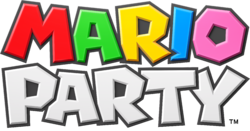 The current logo, formatted like the logo from Mario Party Superstars | |
| First installment | Mario Party (1998) |
| Latest installment | Super Mario Party Jamboree (2024) |
| Number of installments | 26 (13 main, 6 handheld, 7 arcade) |
| Franchise | Super Mario |
- “The Olympics, Final Jeopardy!, monster truck extravaganzas... They're all mere child's play compared to the biggest showcase of brains, talent, and stamina of our time: Mario Party!”
- —Nintendo Power Issue #117, February 1999
The Mario Party series is a series of party games featuring the characters of the Super Mario franchise, in which four human- or computer-controlled characters compete in a board game interspersed with minigames. The series is known for its party game elements, including the often unpredictable multiplayer modes that allow play with up to four (and, in one case, eight) human players. The series was created under Nintendo's supervision by Hudson Soft and CAProduction, and was inaugurated on the Nintendo 64, where its first game launched in Japan on December 18, 1998, and in the West in early 1999.
Hudson developed all main installments until several of its key designers and most of its staff left the company. After eight entries on home consoles and two on handhelds, the ex-Hudson staffers then joined Nd Cube, where they developed Wii Party,[1] then restarted production of the Mario Party series, with the new development studio's first installment, Mario Party 9, releasing on the Wii in 2012.
The Mario Party series currently holds the record for the longest-running minigame series in video game history.[2] According to Nintendo's official reports, by December 2014, the various games in the series had sold a cumulative total of 39.6 million copies worldwide.[3] The series has sold a total of 75.84 million copies.[4]
Gameplay
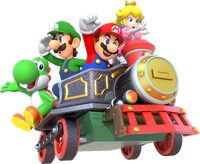
The Mario Party series takes the form of a traditional board game that players can play by directing characters on various themed game boards. Playable character rosters generally consist of major Super Mario characters, including the main protagonist, Mario; his brother, Luigi; his love interest, Princess Peach; his sidekick Yoshi; his antagonists and rivals Wario, Donkey Kong, Waluigi, and Boo; and his friends Toad, Princess Daisy, Toadette, Birdo, and Rosalina, among others. Each game features its own variations on the cast and storyline, with Bowser, the archnemesis of Mario and most of his friends, serving as the main antagonist in most Mario Party titles. There are several modes available for play in each game, each of which provides its own rules and challenges.
Party Mode
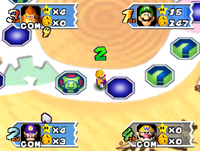
Every game in the "main" branch of the Mario Party series has a standard "Party Mode" in which up to four players play through a board, trying to collect as many Stars as possible. In every turn, each player rolls (hits) a Dice Block and moves ahead the number of spaces shown (ranging from 1 to 10) to make progress on the board, which usually has branching paths. There are many different types of spaces players can land on, each producing a different effect. On most boards, players earn Stars by reaching a Star Space in a random location on the board and purchasing the Star for the specific number of coins stated (usually 20). Every time the Star is purchased, the Star Space moves to one of several predetermined alternate locations, almost always occupying a Blue Space. In early games, players could also pay a visit to or use items with Boo and have him steal coins or Stars from their opponents for 5 or 50 coins, respectively. In addition to buying the Stars, coins are also necessary to purchase power-up items and to determine the game winner in the event of a tie. Players gain coins by landing on Blue Spaces or performing well in the minigame played at the end of each turn, and they lose them by landing on Red Spaces or by losing certain minigames.
At the end of each round of play (i.e., after each of the four players has taken their turn), a random minigame commences. The minigames are generally short (about a minute in length) and fairly simple. In most situations, winners of a minigame receive 10 coins for their victory; sometimes, losers have to pay winners a sum of coins. Each Mario Party game features any number of minigames (ranging from 50 to 90), divided into several different categories. 4-Player minigames include cooperative games, in which all four players collectively win or lose; competitive free-for-alls, in which players must compete against each other in order to win a limited number of coins; and non-competitive free-for-alls, in which players accrue coins independently of one another and one player's loss is not automatically another's gain. Other minigame categories include 2-vs.-2 games, which place players on teams so that they have to cooperate with others to win (though they still compete against each other in the main game); 1-vs.-3 games, where a lone player is placed against a team of three, and either the team or the lone player must survive for a certain amount of time while the opposition tries to take them out; and single-player games, which occur when a player lands on a special space and give them the opportunity to earn or lose coins depending on their performance. Playing in these minigame categories often depends on the color of the space players have landed on. For example, if two players land on a Blue Space and two players land on a Red Space, a 2-vs.-2 minigame is initiated. If a player lands on a green space, the game randomly decides whether the character color is blue or red.
Three new types of minigames were introduced in Mario Party 2. Battle minigames are like the 4-Player minigames, but instead of winners earning 10 coins each, each player contributes a randomly selected number of coins. The winner of the minigame receives approximately 70% of the pot, the second-place finisher receives the other 30%, and a random player occasionally gets coins left over from rounding. Item minigames allow a single player to take a chance to collect an item, which can be used to further their board strategy. Duel minigames pit two players against each other, with the player that initiates the duel wagering coins or even a Star against their opponent; the winner receives all coins or Stars wagered. Starting with Mario Party 7, the player no longer chooses the wager in a duel. Rather, the duel takes place, and the prize to the winner, if any, is randomly determined.
Bowser has taken on varied roles in the gameplay of the Mario Party series. In almost all entries, he can be summoned via a special space of his own, where he tries to steal from the player. Starting in Mario Party 4, he hosts his own minigames, where in addition to rewarding the winning player, he tries to burn the losing players with his fire breath, forcing them to give up coins, items, or even Stars. Bowser's minigames originally appeared only in multiplayer format, but starting in Mario Party 7, single-player games of that category began to be featured. His son, Bowser Jr., got his own minigames starting in Mario Party 9, where he challenges two players to compete in a minigame with him. If Bowser Jr. is successfully defeated, the players each receive five Mini Stars; if not, then he takes five from each player. In Mario Party 10, Bowser became a playable character in a mode all his own, where he, controlled by a fifth player, would challenge the other four players as they progressed through the game by trying to catch them and take away their hit points.
At the end of the game, Bonus Stars are given to the players. In the first six games, there are three Bonus Stars given out. The Coin Star award is given to the player who collected the most coins overall during the game, the Minigame Star award is awarded to the player who collected the most coins in minigames, and the Happening Star award is given to the player who landed on the most Event Spaces. In Mario Party 7, Mario Party 8, and Mario Party DS, the roster of potential Bonus Stars was expanded to six; still, only three would be chosen, and it was random as to which ones got picked. It is common for more than one character to be awarded the same Bonus Star; this happens if there is a tie for the category in question. The player with the most Stars after the bonus awarding has concluded is declared the winner. In the event of a tie, the player with the most coins wins, and if two or more players have the same number of both Stars and coins, a Dice Block is rolled to determine the winner.
Starting in Mario Party 9, the format of the series was overhauled. Instead of trying to collect coins to buy Stars, players receive Mini Stars if they pass by them. While doing that, players must also try to avoid Mini Ztars, which deduct their current number of Mini Stars. Furthermore, Mario Party 9 and Mario Party 10 had all four players moving around together in one vehicle, instead of each player having to wait their turn in a single spot on the board. The number of potential Bonus Stars was reduced to five, and in Mario Party 10, the number of Stars that would be chosen was also reduced to two. At the end of each stage, the number of Mini Stars the player collects is converted into Party Points, which can be used to buy new stages, difficulties, and bonus content.
Most of the handheld installments in the Mario Party series feature drastically different rules than their console counterparts, with the exception of Mario Party DS. Mario Party Advance is a more single-player oriented game in which players go through Shroom City and solve various quests with characters, each having their own story arc. Mario Party: Island Tour has characters racing their opponents to the finish line with each board having unique rules and requirements, and Mario Party: Star Rush has characters exploring a nonlinear, grid-based layout while playing as a generic Toad, collecting characters of the Super Mario franchise as they appear on the board and defeating bosses in their special minigames. Mario Party: The Top 100 focuses entirely on minigames, where the board gameplay is secondary, vice versa to other Mario Party games' focuses on board gameplay.
Minigame mode
In addition to Party Mode, every Mario Party game has a minigame mode in which minigames are played without the board game. Minigame modes vary from game to game, but later games have many different variations. In one such example from Mario Party 5, each player tries to fill a board with as many spaces as possible in their color by winning minigames. In Mario Party 6 and onward, there is one game in the minigame mode intended for single-player mode.
List of games
Home console
| Title | |
|---|---|
| Cover, original release, and system | Synopsis |
| Mario Party | |
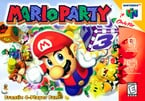 Nintendo 64 |
Mario Party, upon its release for the Nintendo 64 in 1998/1999, introduced a new aspect to multiplayer capabilities in the Super Mario franchise, of which most games before that point mainly featured a two-player versus mode, with the exceptions of a few sports spinoffs. Six characters are playable in the game: Mario, Luigi, Peach, Donkey Kong, Yoshi, and Wario, with Toad being the guide of the game. Each character has one board named and modeled after them (e.g., Mario's Rainbow Castle), in addition to two other boards in the game—one dedicated to Bowser, and another, Eternal Star, unlockable after the player collects 100 Stars.
The game was rereleased for Nintendo 64 - Nintendo Switch Online in 2022. |
| Mario Party 2 | |
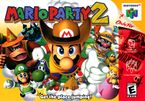 Nintendo 64 |
In 1999/2000, a sequel was released on the Nintendo 64, Mario Party 2. The plot centers around the characters deciding to create their own world, which is named Mario Land, but soon arguing over a good name for the world, only to have the area invaded by Bowser, who partially seizes it for himself. As the characters go through the boards to take back their world, they dress in costumes unique to the board that is being played on (ex. pirate, astronaut, archeologist, etc.) with the exception of Bowser Land where there are no costumes, and after they have finished playing through the board, the winner gets to confront Bowser (in a board-appropriate alter ego) one-on-one and then thwart him. This was the game that introduced items to the series.
The game was rereleased for the Wii through the Virtual Console in 2010, for the Wii U through the Virtual Console in 2016, and for Nintendo 64 - Nintendo Switch Online in 2022. |
| Mario Party 3 | |
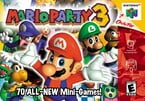 Nintendo 64 |
Mario Party 3, released in 2000/2001 as the final Super Mario entry for the Nintendo 64, centers around a scenario where the Millennium Star, a star reborn once every thousand years, crashes into the grounds of Peach's Castle; Mario and his friends argue over who gets to keep it; and a nearby Lakitu transports everybody into a toy box that they have to navigate to save the star. This game added Daisy and Waluigi as playable characters and was the only entry in the Mario Party series to contain duels where two characters can battle each other using some of the staple enemies of the Super Mario franchise, such as Goombas and Koopa Troopas.
The game rereleased on Nintendo 64 - Nintendo Switch Online in 2023. |
| Mario Party 4 | |
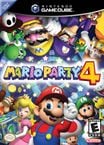 Nintendo GameCube |
Mario Party 4, released in 2002, transitioned the series to the new Nintendo GameCube console. The game centers around a mysterious object called the Party Cube, which grants the wishes of its users; Mario and his friends enter this cube when Toad, Koopa, and several other characters invite them inside to celebrate birthday parties for them. As the player characters progress through boards, they are awarded presents; the story's climax comes in the form of Bowser, who wishes to disrupt the party with a board of his own. This was the last Mario Party game to have Donkey Kong as a playable character until Mario Party 10, and it was also the first entry in the series to grant players the ability to team up. Although this game does not introduce any new fully playable characters, Daisy and Waluigi are both playable in Story Mode (unlike in Mario Party 3). Also, there are characters exclusively playable in the minigame Beach Volley Folly: Toad, Koopa, Shy Guy, Boo, Koopa Kid, and Bowser. |
| Mario Party 5 | |
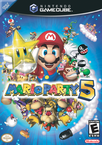 Nintendo GameCube |
Mario Party 5, released in 2003 for the GameCube, is set in the world of Dream Depot, where everybody's dreams come together. The Star Spirits from Paper Mario, who serve as guardians to the dreams there, invite Mario and his friends to the depot, where they try to prevent Bowser and his Koopa Kids from conquering and ruining the place. Toad, Boo, and one of the Koopa Kids take on roles as playable characters for the first time here (in all modes except Story Mode), and Donkey Kong is now restricted to being featured in the special DK Space, which initiates an event granting the possibility of a Star or coins whenever landed on. Also introduced are capsule machines, which dispense containers called capsules that hold items for the player characters to use to their advantage. |
| Mario Party 6 | |
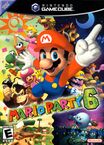 Nintendo GameCube |
Mario Party 6, released in 2004, was the first game to make use of the GameCube's microphone peripheral, packaged with the game. Every three turns, the sun periodically sets or rises, producing different effects, including spaces moving, different characters appearing, and changes to minigames. The game features the sun-and-moon duo of Brighton and Twila as its hosts, who are arguing over who is more popular, which Mario and his friends hope to stop by collecting Stars and completing the Miracle Book. This game marks the first time that Toadette is playable in the series; here, she is an unlockable character, the first player character in the series to be unlockable. Also, Toad, Boo, and Koopa Kid are fully playable for the first time in the series. |
| Mario Party 7 | |
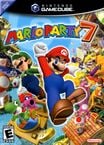 Nintendo GameCube |
Mario Party 7, released in 2005, was the series' last entry on the GameCube. The game again incorporates the microphone mechanic and mic-exclusive minigame format from the previous installment, and it also introduces an eight-player joystick-only game in which up to eight players can party, with two players sharing one controller. In the game's story, Toadsworth, Peach's longtime steward, has invited Mario and all of his friends to go on a luxury cruise around the world as a reward for their hard work. Bowser is not invited, however, and furiously vows to take revenge by turning their vacation paradise into a stress-filled place of pandemonium, so it is up to the passengers to end this. Birdo and Dry Bones are introduced as unlockable playable characters in this game. |
| Mario Party 8 | |
 Wii |
Mario Party 8, released in 2007, launched the Mario Party series to the Wii. A Blooper and one of the Hammer Bros. are added as unlockable playable characters. Hosted by MC Ballyhoo, the self-proclaimed "master of catastrophes" with a talking top hat called Big Top, the game has an assortment of minigames utilizing the capabilities of the new console's remote. It centers around the Star Carnival, which comprises five areas: the Party Tent, where players can have a classic game of Mario Party; the Minigame Tent, an arcade where minigames are played; the Extras Zone, where players can play extra minigames with either the main characters or their Mii avatars; the Fun Bazaar, where players can buy minigames, items, and various other things; and the Star Battle Arena, which acts as the game's story mode. Mario and his friends have been invited to the Star Carnival to party, and the winner of their game gets a year's supply of Candy. However, just as one of the players is crowned the Superstar, Bowser steals the Star Rod they were to receive, and Mario and his friends must defeat Bowser and get it back. |
| Mario Party 9 | |
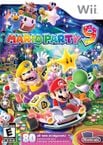 Wii |
Mario Party 9, released in 2012, was the first iteration in the series to be developed by Nintendo Cube. Gameplay uses a mechanic new to the main branch of the series, in which players move around in a vehicle. Players take turns as the captain, rolling the dice to move the vehicle. Instead of attempting to collect coins to buy Stars, the players attempt to earn the most Mini Stars on each board by collecting them from the board, winning minigames, and beating bosses. They must also avoid Mini Ztars, which decrease the player's current total of Mini Stars. The game also has two boss battles integrated into each board; the players try to take down a boss together, while also trying their best to increase their individual scores. The game's plot has Mario and his friends looking at the night sky, when suddenly, Bowser and his son are sucking Mini Stars into a vortex, so Mario and his friends head off to save the Mini Stars. A Koopa Troopa is added as a default playable character (being fully playable for the first time in the series), and Shy Guy and Kamek are introduced as unlockable playable characters (although neither is playable in Story Mode). |
| Mario Party 10 | |
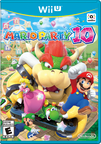 Wii U |
Mario Party 10 is the only Mario Party game for the Wii U, released in 2015. The game reuses the vehicle mechanic, and players once again have the goal of collecting Mini Stars. However, in addition to the traditional Party Mode, two new modes have been added: Bowser Party, where a player using the GamePad plays as Bowser and tries to make the heroes lose all their hearts, and amiibo Party, where players collect Stars with coins using amiibo figures from the Super Mario line. Bowser's playability in his special mode and amiibo Party aside, the game also adds Rosalina as a default playable character and Spike as an unlockable playable character. In addition, Donkey Kong returns as a fully playable character for the first time since Mario Party 4. |
| Super Mario Party | |
 October 5, 2018 Nintendo Switch |
Super Mario Party is a Mario Party game for the Nintendo Switch, released in 2018. The game returns to the series' roots, with the turn-based, linear, individually moving style gameplay from the first eight home console installments. This game brings back the ally system from Mario Party: Star Rush and some boards using the nonlinear style of said game in the Partner Party mode, albeit with individual turns. In addition to this, there are two other featured modes: River Survival and Sound Stage. Both of these modes feature unique minigames that are exclusive to these modes, and both modes feature different gameplay from the basic Mario Party mode. The game also introduces Goomba, Monty Mole, and Pom Pom as new playable characters. Later in 2018, a browser game on the Play Nintendo website called Super Mario Party Fun Trivia Quiz appeared. |
| Mario Party Superstars | |
 October 29, 2021 Nintendo Switch |
Mario Party Superstars is the second Mario Party game for the Nintendo Switch, released on October 29, 2021. The game follows the gameplay style of Super Mario Party and earlier installments in the series. It features 100 minigames from past titles, similarly to Mario Party: The Top 100, as well as five boards originally from the first three titles.
This would be the last Mario Party game to feature Charles Martinet's voice work before it was announced that he had moved to the role of Mario Ambassador. |
| Super Mario Party Jamboree | |
 October 17, 2024 Nintendo Switch |
Super Mario Party Jamboree is the third Mario Party game for the Nintendo Switch, released on October 17, 2024. Serving as a successor to Super Mario Party, this game primarily features gameplay modeled after Mario Party Superstars. It includes new and returning game boards, over 110 minigames, and more playable characters than previous titles, including newcomers Pauline and Ninji.
This was the first Mario Party game to feature Kevin Afghani voicing Mario, Luigi, Wario, and Waluigi, as well as the first game overall where he voiced Waluigi. |
Handheld
| Title | |
|---|---|
| Cover, original release, and system | Synopsis |
| Mario Party-e | |
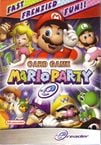 GBA e-Reader |
Mario Party-e is a card game released in 2003 that makes optional use of the Nintendo e-Reader. Many of these cards contain "dot-codes" that, when scanned into the e-Reader, allow players to play minigames similar to those found in the regular Mario Party series. The Mario Party-e package contains a play mat, an instruction book, and a pre-constructed deck consisting of 64 cards. An extra card was included as a promotion in an issue of the magazine GamePro. |
| Mario Party Advance | |
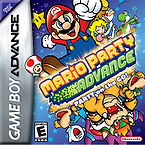 Game Boy Advance |
Mario Party Advance, released on the Game Boy Advance in 2005, was the first full Mario Party release on a handheld gaming system. Instead of the multiplayer Party Mode that is traditional to the series, Mario Party Advance features a new mode called Shroom City, where players must collect all the minigames and Gaddgets that were scattered around the city by Bowser, completing quests assigned by the various inhabitants of Shroom City. Unlike other installments of the Mario Party series, this game is almost exclusively single-player. This game introduces the mechanic of having players move around in a vehicle, which was later used in Mario Party 9 and Mario Party 10.
The game was rereleased for the Wii U through the Virtual Console, initially in 2014. |
| Mario Party DS | |
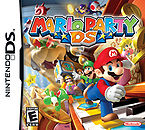 Nintendo DS |
Mario Party DS, released for the Nintendo DS in 2007, was the last iteration in the series to be developed by Hudson. It features many minigames that utilize the capabilities of the DS's touchscreen and microphone, in addition to traditional minigames using the directional pad and control buttons. The story revolves around five meteorites called Sky Crystals, which fall onto the earth one day. While Mario and the gang are discussing this, Kamek drops them party invitations from Bowser, who has invited them to his castle for a banquet; however, once they arrive, they are all captured, shrunk to a microscopic size, and thrown outside. The player characters must return to Bowser's Castle to be restored to their normal height.
The game was rereleased for the Wii U through the Virtual Console in 2016. |
| Mario Party: Island Tour | |
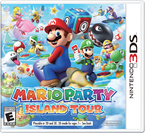 Nintendo 3DS |
Mario Party: Island Tour, released for the Nintendo 3DS in 2013, was the second Mario Party installment to be developed by Nintendo Cube. The game returns to the traditional individual player movement of the Mario Party series, but each board has its own unique style of gameplay. Many minigames are designed to utilize the Touch Screen and other unique features of the system. Bowser Jr. is playable for the first time in the series in this game. |
| Mario Party: Star Rush | |
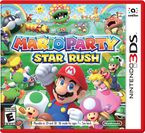 Nintendo 3DS |
Mario Party: Star Rush, released for the Nintendo 3DS in 2016, deviates from the normal format in its removal of turn-based gameplay in favor of the ability to move at will, simultaneous with other players, and without set paths on the game board. The main mode in this installment is Toad Scramble, where all players play as Toad in one of his various color schemes and can recruit other characters to play with them on their teams. Mario Party: Star Rush is the first handheld release in the series to be amiibo-compatible. It is also the first game in the series to have Diddy Kong as a playable character, after he had non-playable roles in Mario Party DS and Mario Party 9. |
| Mario Party: The Top 100 | |
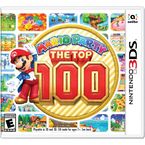 Nintendo 3DS |
Mario Party: The Top 100, released for the Nintendo 3DS in 2017, compiles 100 minigames from past home console Mario Party games with altered graphics and controls. These minigames can be played in a variety of ways through the game's modes, such as through the single-player Minigame Island mode. |
Arcade
In addition to its home console and handheld installments, the Mario Party brand has also been licensed into seven Japan-only arcade games. Six were developed by Capcom:
- Super Mario Fushigi no Korokoro Party ("Super Mario Rolling Party of Mystery"), released in 2004
- Super Mario Fushigi no Korokoro Party 2 ("Super Mario Rolling Party of Mystery 2"), released in 2005
- Mario Party Fushigi no Korokoro Catcher ("Mario Party Mysterious Rolling Catcher"), released in 2009
- Mario Party Kurukuru Carnival ("Mario Party Spinning Carnival"), released in 2012
- Mario Party Fushigi no Korokoro Catcher 2 ("Mario Party Mysterious Rolling Catcher 2"), released in 2013
- Mario Party Challenge World, released in 2016
One was developed by Banpresto:[5]
- Dokidoki Mario Chance!, released in 2003[6]
These games generally feature minigames from the main entries in the Mario Party series, and can be played by up to six players instead of the normal four, except for the one-player game Dokidoki Mario Chance![7]
Playable characters
The Mario Party series features a total of 30 playable characters among its various installments. Below is a list of these characters and the games in which they are playable.
| Key | Available from the start | Unlocked by fulfilling in-game requirements |
Playable only in certain modes, must be unlocked beforehand |
Playable only in certain modes, available from start |
|---|
| Character | MP | MP2 | MP3 | MP4 | MP5 | MP6 | MPA | MP7 | MP8 | MPDS | MP9 | MPIT | MP10 | MPSR | MPTT100 | SMP | MPS | SMPJ | Nbr. of appearances |
|---|---|---|---|---|---|---|---|---|---|---|---|---|---|---|---|---|---|---|---|
| Mario | 18 | ||||||||||||||||||
| Luigi | 18 | ||||||||||||||||||
| Peach | 18 | ||||||||||||||||||
| Yoshi | 18 | ||||||||||||||||||
| Wario | 17 | ||||||||||||||||||
| Donkey Kong | 10 | ||||||||||||||||||
| Daisy | 15 | ||||||||||||||||||
| Waluigi | 15 | ||||||||||||||||||
| Toad | 11 | ||||||||||||||||||
| Shy Guy | 4 | ||||||||||||||||||
| Boo | 9 | ||||||||||||||||||
| Koopa Troopa | 4 | ||||||||||||||||||
| Koopa Kid | 3 | ||||||||||||||||||
| Bowser | 5 | ||||||||||||||||||
| Toadette | 6 | ||||||||||||||||||
| Birdo | 5 | ||||||||||||||||||
| Dry Bones | 3 | ||||||||||||||||||
| Blooper | 1 | ||||||||||||||||||
| Hammer Bro | 2 | ||||||||||||||||||
| Mii | 1 | ||||||||||||||||||
| Kamek | 1 | ||||||||||||||||||
| Bowser Jr. | 4 | ||||||||||||||||||
| Rosalina | 6 | ||||||||||||||||||
| Spike | 2 | ||||||||||||||||||
| Diddy Kong | 2 | ||||||||||||||||||
| Red Toad | 1 | ||||||||||||||||||
| Blue Toad | 1 | ||||||||||||||||||
| Green Toad | 1 | ||||||||||||||||||
| Yellow Toad | 1 | ||||||||||||||||||
| Goomba | 2 | ||||||||||||||||||
| Monty Mole | 2 | ||||||||||||||||||
| Pom Pom | 1 | ||||||||||||||||||
| Pauline | 1 | ||||||||||||||||||
| Ninji | 1 | ||||||||||||||||||
| Unique characters introduced | 6 | 0 | 2 | 6 | 0 | 1 | 0 | 2 | 3 | 0 | 1 | 1 | 2 | 5 | 0 | 3 | 0 | 2 | |
| Total playable characters | 6 | 6 | 8 | 14 | 11 | 11 | 4 | 12 | 15 | 8 | 12 | 10 | 13 | 19 | 8 | 20 | 10 | 22 |
Notes
– Playable character
- Blank – Not playable
– Unknown status
1 - Not playable in Story Mode.
2 - Not playable in modes that exclusively involve the use of amiibo.
3 - Playable only in Mario Shuffle by scanning amiibo.
4 - Not playable in Toad Scramble.
5 - Playable only in Toad Scramble.
6 - Not playable in Koopathlon and Bowser Kaboom Squad.
List of boards
- Main article: Board (Mario Party series)
Nearly all Mario Party games feature boards, with spaces to move around on using dice blocks. Starting with Mario Party 6, some boards became more linear, and games from Mario Party 9 on heavily changed the format until Super Mario Party returned to a more classic style.
Mario Party Advance also featured a mode called Bonus Board, which is played on a physical game board.
Lists of minigames
A major hallmark of the Mario Party series that has contributed greatly to its popularity is its tremendous supply of minigames. In total, 1,262 minigames have been designed for the various games in the series, including returning minigames. Very rarely do the English minigame names correspond to the Japanese originals; Nintendo of America's localization team changed most minigame names to use word rhyme, alliteration, puns on English-language phrases, and references to United States and international popular culture. This practice was also done by Nintendo of Europe for Mario Party: Island Tour and, to a lesser extent, Mario Party 10, when it produced its own localizations in lieu of using those of the American division.
|
Reception
- “Spending just a measly hour with this miserable, cancer-of-the-brain-inducing game is like going naked hot-tubbing with Rush Limbaugh as your parents cheer and snap photos. I didn't think it was humanly possible for this series to get any worse than it was, but this entry wailed on my unmentionables until they were well past black and blue.”
- —Andrew Reiner, Game Informer issue #128
Critical reception to the Mario Party series ranges from mixed to positive, with much of the praise for the games going towards the multiplayer modes. On Metacritic, individual installments in the series have aggregate review scores ranging from 54 (for Mario Party Advance) to 82 (for Super Mario Party Jamboree) out of 100. While the Nintendo 64 installments garnered generally positive reviews,[8][9] reception to the following games developed by Hudson Soft was more mixed, with critics lambasting the lack of changes done to the formula and dull single-player gameplay.[10] Mario Party 9's overhaul of the mechanics received praise from critics,[11] and the Nintendo Switch installments are the best-received in the series,[12][13][14] although reception to the 3DS installments as well as Mario Party 10 have been more negative.[15][16][17][18] The gaming magazine Game Informer in particular was infamous for its consistently vitriolic review of the series, as the quote above shows, leading Nintendo of America to send a sarcastic certificate to the magazine's office over its reviews of Mario Party and Mario Party 2.
Controversies
In Mario Party, certain minigames required players to rotate the controller's joystick, including one at the Mini-Game House in which the player is challenged to wind up a mechanical Fly Guy toy. Some players used the palms of their hands, rather than their thumbs, to rotate the joystick. As a result, they often endured blisters. In an act of contrition, Nintendo gave away free gaming gloves to the victims of these blisters.[19] Some wore away the joystick because it was not very durable. So negative was the response to these minigames that Nintendo decided to largely retire joystick rotation from the series' sequels. The only exception to this rule is Vicious Vending from Mario Party 5, where the joystick must be rotated only once to turn a lever; additionally, in Mario Party 4, the joystick must be rotated once in the Lottery Shop. The Nintendo 64 - Nintendo Switch Online version of Mario Party includes a notice advising of Nintendo's recommendation to rotate the joystick with one's thumb, and the Mario Party Superstars version of Tug o' War contains a warning against rotating with one's palm. 360-degree control rotation in minigames returned in Mario Party: Island Tour, where the series was introduced to the Nintendo 3DS, which has a circle pad that players can spin safely.
In July 2007, Mario Party 8 was recalled from United Kingdom game stores shortly after its release date.[20] Though Nintendo cited it as the result of a mere assembly error, this allegedly came about because on the board Shy Guy's Perplex Express, when Kamek utters a magic spell to alter the order of cars on the board, he uses the word "spastic," a term used to refer to an intellectually disabled person. Complaints were raised from consumers because the aforementioned term is considered highly offensive in the United Kingdom. As such, the game was temporarily banned from the UK while the offending word was replaced at code level and the software was reproduced. Mario Party 8 was rereleased in August 2007 with "erratic" used instead.[21] North American copies released afterwards had the line changed completely to "Let me use my magic to make this all a little more interesting!"[22]
Gallery
Names in other languages
| Language | Name | Meaning | Notes |
|---|---|---|---|
| Japanese | マリオパーティ[?] Mario Pāti |
Mario Party | |
| Chinese (simplified) | 马力欧派对[?] Mǎlìōu Pàiduì |
Mario Party | |
| Chinese (traditional) | 瑪利歐派對[?] Mǎlìōu Pàiduì |
Mario Party | |
| Korean | 마리오 파티[?] Mario Pati |
Mario Party |
Trivia
- Luigi mentions the Mario Party series in his diary in Paper Mario.
- The Mario Party games are mentioned in one of the Coin Block/Brick Block cards in Nintendo Monopoly. Here, the player gets $50 from every player for organizing a Mario Party in the 2006 version and $10 in the 2010 version.
References
- ^ Ashcraft, Brian (August 25, 2010). "What Wii Party and Mario Party Have in Common". Kotaku. August 26, 2010.
- ^ Guinness World Records 2011: Gamer's Edition. Guinness World Records Ltd. 2010. Pg. 86. ISBN 978-1-4053-6546-8.
- ^ "Bring along your amiibo as your party plus: one from March 20th in Mario Party 10. Nintendo of Europe. February 19, 2015.
- ^
Mario Party to Mario Party: Island Tour: 39.6 million
Mario Party 10: 2.26 million
Mario Party: Star Rush and Mario Party: The Top 100: 427,566 (Japan)
Super Mario Party: 20.66 million
Mario Party Superstars: 12.89 million
- ^ ドキドキマリオチャンス!. Amusement Journal. Retrieved June 18, 2019.
- ^ 【ドキドキマリオチャンス!】商品詳細情報. TESSIN CREATE CO.,LTD. Retrieved June 18, 2019.
- ^ Borp's coverage on Mario Boards
- ^ http://www.metacritic.com/game/nintendo-64/mario-party
- ^ http://www.metacritic.com/game/nintendo-64/mario-party-3
- ^ Mario Party series ratings
- ^ http://www.metacritic.com/game/wii/mario-party-9
- ^ https://www.metacritic.com/game/super-mario-party/
- ^ Metacritic score for Mario Party Superstars. Metacritic. Retrieved February 6th, 2022.
- ^ https://www.metacritic.com/game/super-mario-party-jamboree/
- ^ http://www.metacritic.com/game/3ds/mario-party-island-tour
- ^ http://www.metacritic.com/game/wii-u/mario-party-10
- ^ http://www.metacritic.com/game/3ds/mario-party-star-rush
- ^ http://www.metacritic.com/game/3ds/mario-party-the-top-100
- ^ "Nintendo to hand out gaming gloves". BBC News. March 9, 2000.
- ^ Richards, Jonathan. "Nintendo withdraws game that taunts spastics". The Times of London. July 17, 2007.
- ^ "Non-spastic Mario Party 8 returns Aug. 8 to Europe". Weblogs, Inc. July 27, 2007.
- ^ Mario Party 8. The Cutting Room Floor. Retrieved July 04, 2024.
